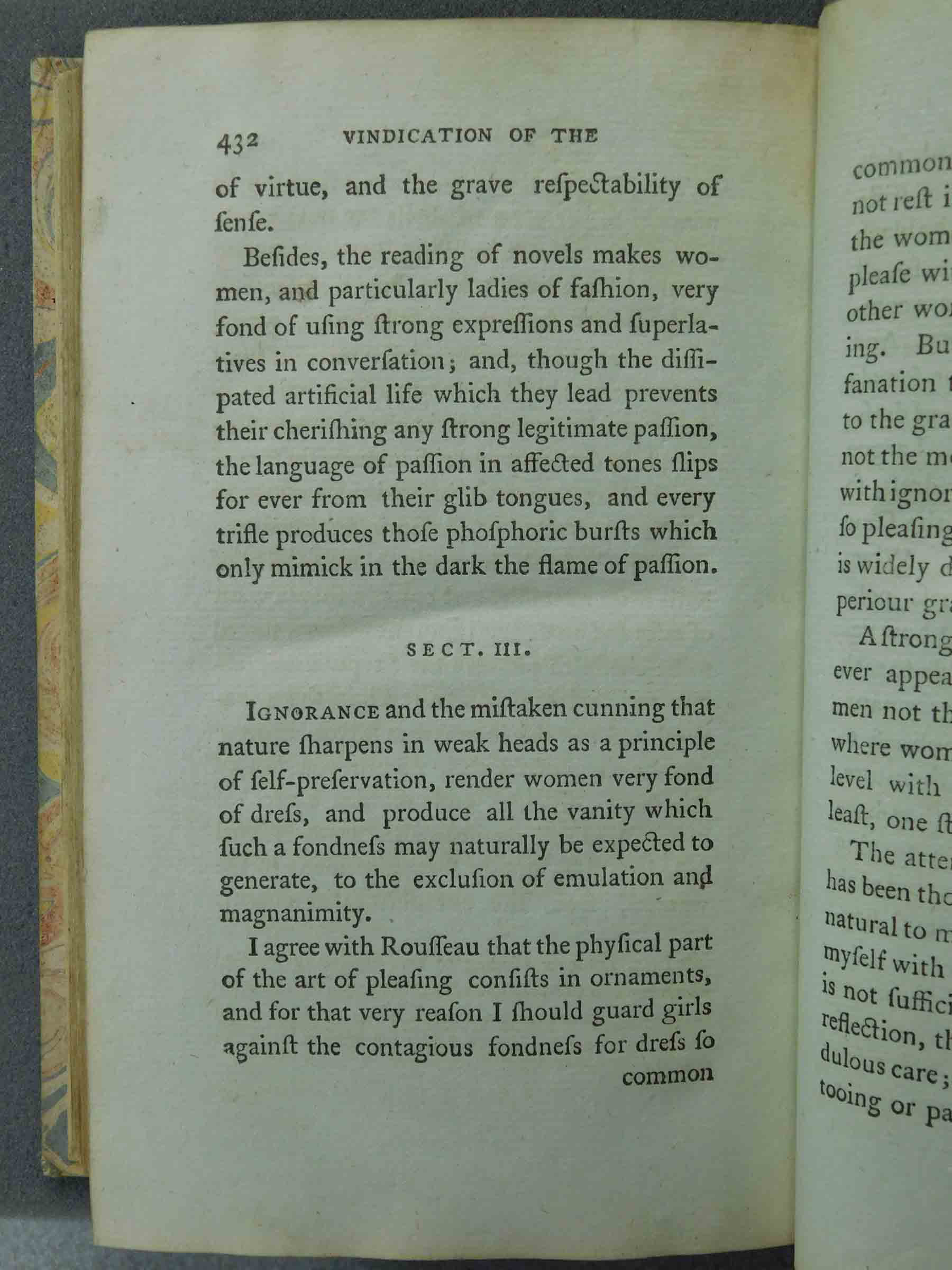A Vindication of the Rights of Woman
By
Mary Wollstonecraft
Transcription, correction, editorial commentary, and markup by Students and Staff of Marymount University, Felix Baquedano, Nomin Bayanmunkh, Rewan Bezabih, Rosaida De Jesus, Josephine Fleming, Daryl Frierson, Tierney Goetz, Alexandra Holmes, Muna Mohamed, Sarah Moustafa, Dana Najib, Maria Robelo, Katelyn Smolar, Elizabeth Swanson, Bianca Thompson, Susana Valladares
wollstonecraft
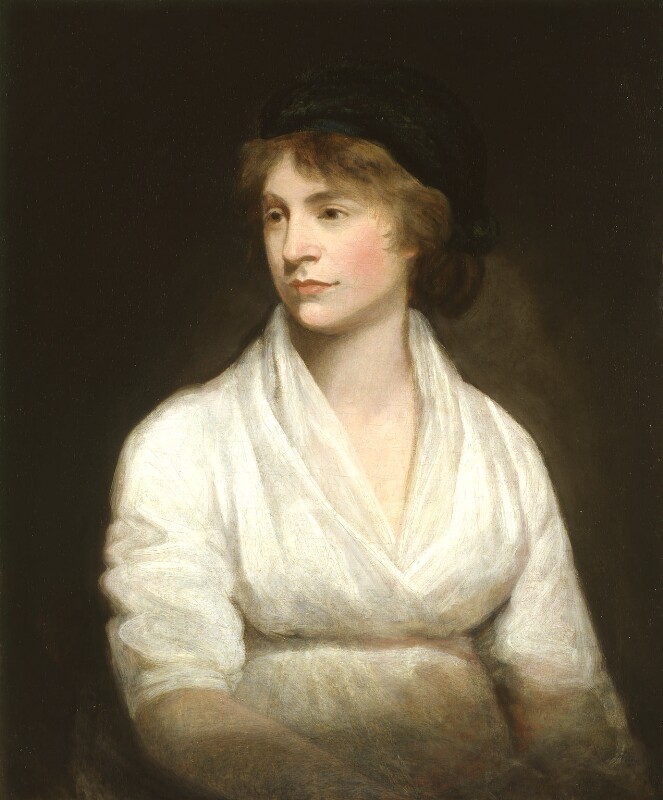 Born in London on April 27, 1759, Mary Wollstonecraft is considered
one of the principal figures in modern feminism. Her works reflected her unmarried
middle class experience, emphasizing gender injustice, the failure of the education
system for young women, and the position of women in unhappy marriages. Her best known
work, Vindication of the Rights of Women (1792), argues that to
attain virtue, women need access to systemic education. See this biographical essay on Wollstonecraft by Janet Todd. The portrait of
Wollstonecraft included here, painted by John Opie (1797), is housed in the National Portrait Gallery, London. - [MUstudstaff]mahometanism
Born in London on April 27, 1759, Mary Wollstonecraft is considered
one of the principal figures in modern feminism. Her works reflected her unmarried
middle class experience, emphasizing gender injustice, the failure of the education
system for young women, and the position of women in unhappy marriages. Her best known
work, Vindication of the Rights of Women (1792), argues that to
attain virtue, women need access to systemic education. See this biographical essay on Wollstonecraft by Janet Todd. The portrait of
Wollstonecraft included here, painted by John Opie (1797), is housed in the National Portrait Gallery, London. - [MUstudstaff]mahometanism
 Source: 1848 lithograph by James Rattray showing an Afgan women under purdahA term used by Westerners to refer to Muslims, in this context
Mahometanism is associated with the limited opportunities and oppressed status of women
in the eighteenth century. As discussed in The
Feminization Debate in Eighteenth-Century England (2004) by E. Clery,
women were trained to obey their father and husband. This confinement and
domesticization was frequently described as "Mahometan" due to the misguided belief
among the English that Islam sees women as not possessing souls. Social reformer and
leader of the Blue Stockings Society, Elizabeth Montagu lamented in a letter about the
effects of such "Mahometan" belief, which is used to justify women's domestic
confinement (Clery 136). The image included here, an 1848 lithograph by James Rattray, shows
Afgan women under purdah. Image via
Wikimedia Commons. - [BT]education
Source: 1848 lithograph by James Rattray showing an Afgan women under purdahA term used by Westerners to refer to Muslims, in this context
Mahometanism is associated with the limited opportunities and oppressed status of women
in the eighteenth century. As discussed in The
Feminization Debate in Eighteenth-Century England (2004) by E. Clery,
women were trained to obey their father and husband. This confinement and
domesticization was frequently described as "Mahometan" due to the misguided belief
among the English that Islam sees women as not possessing souls. Social reformer and
leader of the Blue Stockings Society, Elizabeth Montagu lamented in a letter about the
effects of such "Mahometan" belief, which is used to justify women's domestic
confinement (Clery 136). The image included here, an 1848 lithograph by James Rattray, shows
Afgan women under purdah. Image via
Wikimedia Commons. - [BT]education
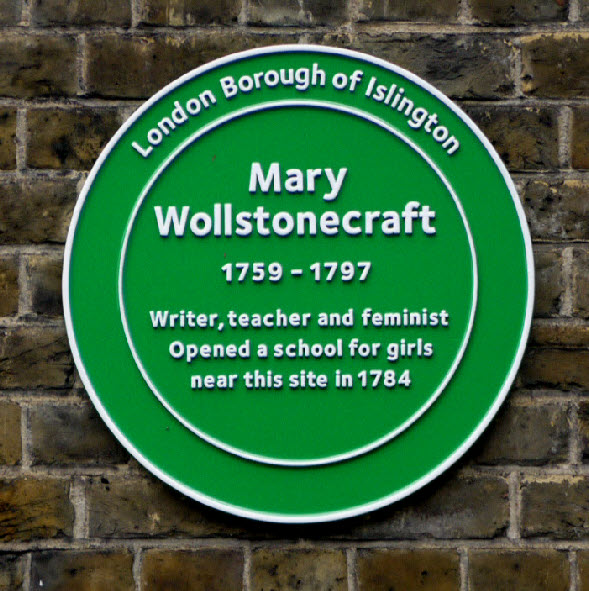 Mary Wollstonecraft noted the absence of proficient education for
young women in the eighteenth century and decided to establish a school. Wollstonecraft,
along with her sister Eliza, and friend Fanny Blood, opened the school in 1784. The
school was established in Newington Green just outside of London. Although the school
closed from financial distress in 1785, Wollstonecraft drew from her experience as a
teacher and wrote Thoughts on the Education of Daughters with
Reflections on Female Conduct in the more important Duties of Life (1787). The
above picture shows a plaque dedicated to Mary Wollstonecraft at the Newington Green
Primary School near where the school was located in the 18th century. For more
information on the life of Mary Wollstonecraft, read this biographical essay
written by Sylvana Tomaselli. To look through a copy of Wollstonecraft's Thoughts on the Education of Daughters with Reflections on Female
Conduct in the more important Duties of Life click here for an
online version of the book from the London School of Economics’ digital library. - [NB]trifling_employments
Mary Wollstonecraft noted the absence of proficient education for
young women in the eighteenth century and decided to establish a school. Wollstonecraft,
along with her sister Eliza, and friend Fanny Blood, opened the school in 1784. The
school was established in Newington Green just outside of London. Although the school
closed from financial distress in 1785, Wollstonecraft drew from her experience as a
teacher and wrote Thoughts on the Education of Daughters with
Reflections on Female Conduct in the more important Duties of Life (1787). The
above picture shows a plaque dedicated to Mary Wollstonecraft at the Newington Green
Primary School near where the school was located in the 18th century. For more
information on the life of Mary Wollstonecraft, read this biographical essay
written by Sylvana Tomaselli. To look through a copy of Wollstonecraft's Thoughts on the Education of Daughters with Reflections on Female
Conduct in the more important Duties of Life click here for an
online version of the book from the London School of Economics’ digital library. - [NB]trifling_employments
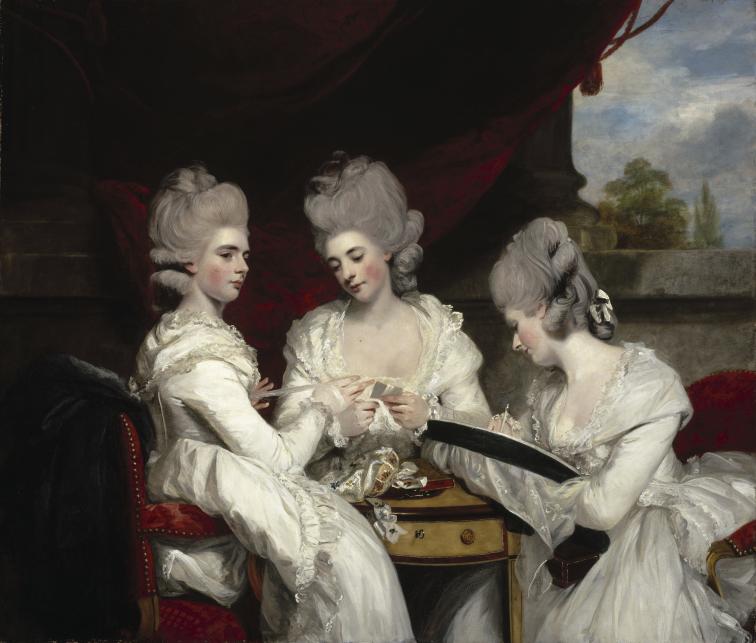 By "trifling employments," Wollstonecraft refers to the kinds of
things elegant women did to employ their time such as needlepoint. Not allowed to
participate in the masculine public sphere, women instead spent their time in domestic
labor and activities. Many were mothers and homemakers. These activities were not
masculine and serious but feminine and trifling. Read more on women’s work in the
eighteenth century in this article by
Susan E. Jones, also the source of this annotation. The portrait above, via the Frick
Collection, is a conversation piece by Joshua Reynolds (1723–1792) showing the
genteel young ladies Waldegrave engaged in such domestic work. - [MM]history This is likely a reference to
discussions about the hierarchy of genres during the eighteenth century. Dorothee Birke,
author of Writing the Reader: Configurations of Cultural Practice in English Novel
(2016), explains that historical and philosophical works were seen to have
higher value than novels and poetry. The reason behind such a hierarchical placement is
the perception of fictional reading to be connected with ignorance as people are fed
unrealistic words. Thus, historical and philosophical works which were often based on
truth and it reality, were insightful readings that were ranked higher than unrealistic
or exaggerated works (Birke 63). - [DN]sandford_merton Likely a reference to a popular
children’s book written in the eighteenth century, Sandford and
Merton (1783), by Thomas Day, is about two boys who grow up differently based on
social status. According to
Stephen Bending and Stephen Bygrave, the book is an indictment of upper class
"effete" masculinity (23). Tommy Merton is spoiled by middle class privileges and needs
to be re-educated to become as fine a man as Sandford, whose lower-class status
challenged him to develop, physically and mentally, into an admirable young man (3-4).
Interested viewers can also read an abridged
version of Day’s children’s book, published in 1792, at the Internet Archive. - [SV]novelistsWollstonecraft's question refers to an
ongoing discussion about the work of novel-reading on young girls' intellectual growth.
It was thought dangerous for women to read novels because society feared that they would
not, as Anna North writes in "When Novels Were Bad for You," be able to "differentiate between fiction and
life." - [KS]bubbled
By "trifling employments," Wollstonecraft refers to the kinds of
things elegant women did to employ their time such as needlepoint. Not allowed to
participate in the masculine public sphere, women instead spent their time in domestic
labor and activities. Many were mothers and homemakers. These activities were not
masculine and serious but feminine and trifling. Read more on women’s work in the
eighteenth century in this article by
Susan E. Jones, also the source of this annotation. The portrait above, via the Frick
Collection, is a conversation piece by Joshua Reynolds (1723–1792) showing the
genteel young ladies Waldegrave engaged in such domestic work. - [MM]history This is likely a reference to
discussions about the hierarchy of genres during the eighteenth century. Dorothee Birke,
author of Writing the Reader: Configurations of Cultural Practice in English Novel
(2016), explains that historical and philosophical works were seen to have
higher value than novels and poetry. The reason behind such a hierarchical placement is
the perception of fictional reading to be connected with ignorance as people are fed
unrealistic words. Thus, historical and philosophical works which were often based on
truth and it reality, were insightful readings that were ranked higher than unrealistic
or exaggerated works (Birke 63). - [DN]sandford_merton Likely a reference to a popular
children’s book written in the eighteenth century, Sandford and
Merton (1783), by Thomas Day, is about two boys who grow up differently based on
social status. According to
Stephen Bending and Stephen Bygrave, the book is an indictment of upper class
"effete" masculinity (23). Tommy Merton is spoiled by middle class privileges and needs
to be re-educated to become as fine a man as Sandford, whose lower-class status
challenged him to develop, physically and mentally, into an admirable young man (3-4).
Interested viewers can also read an abridged
version of Day’s children’s book, published in 1792, at the Internet Archive. - [SV]novelistsWollstonecraft's question refers to an
ongoing discussion about the work of novel-reading on young girls' intellectual growth.
It was thought dangerous for women to read novels because society feared that they would
not, as Anna North writes in "When Novels Were Bad for You," be able to "differentiate between fiction and
life." - [KS]bubbled
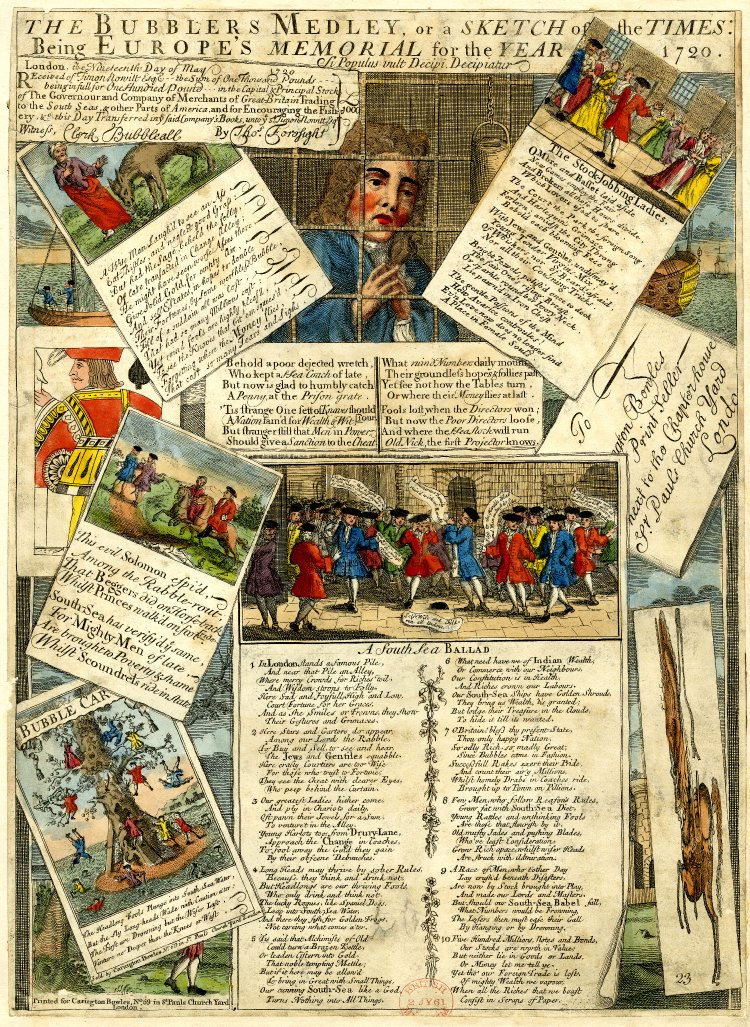 According to the Oxford English Dictionary, in the eighteenth-century
the word "bubbled" meant befooled, cheated, or deceived. Here, Wollstonecraft is saying
women’s understandings have been fooled by the popularization and distribution of
conduct books and their false depiction of women. "Bubbled" in this usage is also
derived from the devastating financial bubble in the eighteenth century, including the
South Sea Bubble of 1720. Many engravings and satirical prints of the time depict how
the people were deceived and cheated financially, most notably, The
Bubbler’s Medley, or a Sketch of the Times being Europe’s Memoriam for 1720.
The image included here is from the British Museum's online collection. To read more, visit Harvard Business School’s
online exhibit on the South Sea Bubble, and the source of this annotation. - [JMF]conduct
According to the Oxford English Dictionary, in the eighteenth-century
the word "bubbled" meant befooled, cheated, or deceived. Here, Wollstonecraft is saying
women’s understandings have been fooled by the popularization and distribution of
conduct books and their false depiction of women. "Bubbled" in this usage is also
derived from the devastating financial bubble in the eighteenth century, including the
South Sea Bubble of 1720. Many engravings and satirical prints of the time depict how
the people were deceived and cheated financially, most notably, The
Bubbler’s Medley, or a Sketch of the Times being Europe’s Memoriam for 1720.
The image included here is from the British Museum's online collection. To read more, visit Harvard Business School’s
online exhibit on the South Sea Bubble, and the source of this annotation. - [JMF]conduct
 Source: The Title page of Gregory's conduct book
This is most likely a reference to Dr. John Gregory’s A Father’s Legacy to His Daughters, a conduct book written prior
to Dr. Gregory’s wife’s passing in 1761 and addressed to his daughters about etiquette,
religion, conduct, and behaviors. Wollstonecraft references this book directly in many
of her arguments. The image of the book's title page (1795) is from the University of Delaware Special Collections Department is from the National Library of Scotland. View a 1793 edition of A Father’s Legacy to His Daughters at the Internet
Archive. - [BT]johnson
Source: The Title page of Gregory's conduct book
This is most likely a reference to Dr. John Gregory’s A Father’s Legacy to His Daughters, a conduct book written prior
to Dr. Gregory’s wife’s passing in 1761 and addressed to his daughters about etiquette,
religion, conduct, and behaviors. Wollstonecraft references this book directly in many
of her arguments. The image of the book's title page (1795) is from the University of Delaware Special Collections Department is from the National Library of Scotland. View a 1793 edition of A Father’s Legacy to His Daughters at the Internet
Archive. - [BT]johnson
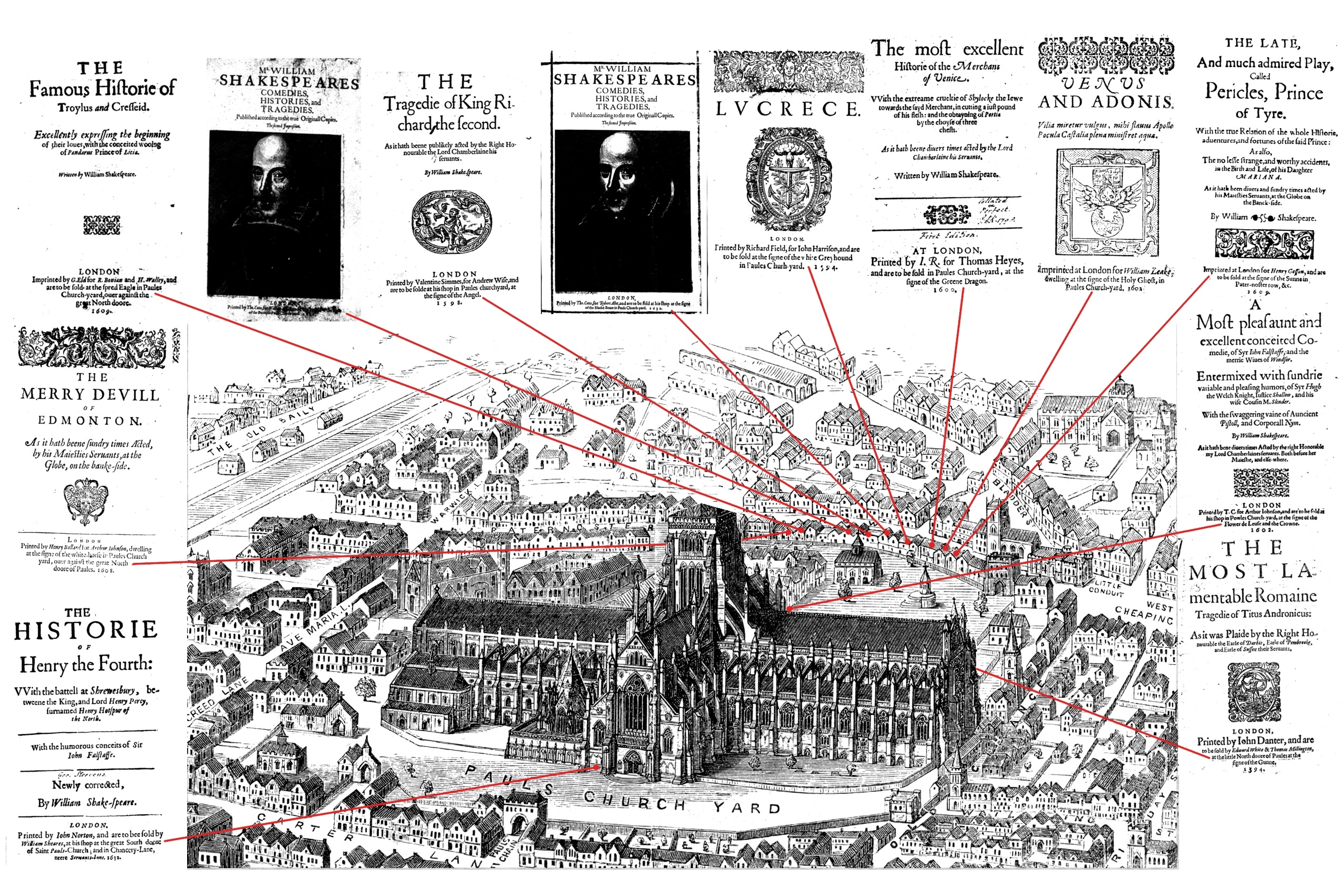 Throughout the eighteenth century, St. Paul’s Church Yard was the center of the
publishing trade. Wollstonecraft's Vindications was published by
Joseph Johnson, a liberal publisher with radical views, who published work by William
Godwin, Joseph Priestly, and William Blake. Wollstonecraft lived near St. Paul’s Church
Yard and spent many hours in this workshop as Joseph Johnson gave her writing and
translating jobs throughout the day. For more on the relationship between Mary
Wollstonecraft and Joseph Johnson, see this letter from Wollstonecraft to her publisher reprinted in The
American Reader. The image here, from a University of Louisville news
article on William Shakespeare's first folio, shows the locations of printers around St.
Paul's during the late sixteenth and early seventeenth centuries. - [TH]elegance
Throughout the eighteenth century, St. Paul’s Church Yard was the center of the
publishing trade. Wollstonecraft's Vindications was published by
Joseph Johnson, a liberal publisher with radical views, who published work by William
Godwin, Joseph Priestly, and William Blake. Wollstonecraft lived near St. Paul’s Church
Yard and spent many hours in this workshop as Joseph Johnson gave her writing and
translating jobs throughout the day. For more on the relationship between Mary
Wollstonecraft and Joseph Johnson, see this letter from Wollstonecraft to her publisher reprinted in The
American Reader. The image here, from a University of Louisville news
article on William Shakespeare's first folio, shows the locations of printers around St.
Paul's during the late sixteenth and early seventeenth centuries. - [TH]elegance
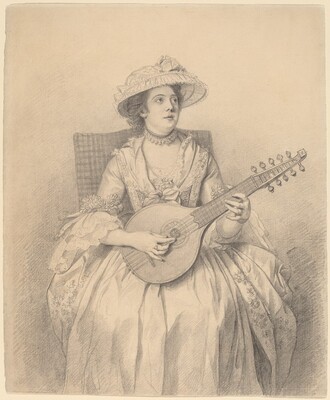 Elegance in the 18th century has a specific meaning when applied to
women. According to Robert
W. Jones, author of Gender and the Formation of Taste in
Eighteenth-Century Britain, feminine elegance is the combination of
docility and enticement of men. In the eighteenth century, elegance is feminized with
the goal that women should use it to please and seduce men through beauty and
refinement. Elegance of the eighteenth century is the area of the pleasing and amiable
actions from women to men, these beauty standards were important and a source of
intrigue for the culture (Jones 109). The image here, drawn from the National Gallery of
Art in Washington, DC, shows An Elegant Lady Playing a Cittern (1770), by Nathaniel
Dance-Holland. - [SM]virtue Mary Wollstonecraft uses "virtue" with
its eighteenth-century sense of power. Men were often seen as virtuous because of their
physical strength, whereas women acquired virtue through sensibility and virginity.
Wollstonecraft argues that true virtue can only exist with knowledge and education.
Therefore, women must be properly educated or they would only be mimicking true virtue.
Views of Women in
Eighteenth Century Literature," published in the International
Journal of Communication Research by Adrian Brunello and Florina-Elena
Borsan reviews the way that understandings of womanhood shifted in the period, resulting
in the need for an exterior display of virtue, rather than true virtue (325-326). clicking here will direct you to the UK National Gallery of Art, showing An Allegory of Virtue and Riches, painted in 1667 by Godfried
Schalcken.
- [RB]schools
Elegance in the 18th century has a specific meaning when applied to
women. According to Robert
W. Jones, author of Gender and the Formation of Taste in
Eighteenth-Century Britain, feminine elegance is the combination of
docility and enticement of men. In the eighteenth century, elegance is feminized with
the goal that women should use it to please and seduce men through beauty and
refinement. Elegance of the eighteenth century is the area of the pleasing and amiable
actions from women to men, these beauty standards were important and a source of
intrigue for the culture (Jones 109). The image here, drawn from the National Gallery of
Art in Washington, DC, shows An Elegant Lady Playing a Cittern (1770), by Nathaniel
Dance-Holland. - [SM]virtue Mary Wollstonecraft uses "virtue" with
its eighteenth-century sense of power. Men were often seen as virtuous because of their
physical strength, whereas women acquired virtue through sensibility and virginity.
Wollstonecraft argues that true virtue can only exist with knowledge and education.
Therefore, women must be properly educated or they would only be mimicking true virtue.
Views of Women in
Eighteenth Century Literature," published in the International
Journal of Communication Research by Adrian Brunello and Florina-Elena
Borsan reviews the way that understandings of womanhood shifted in the period, resulting
in the need for an exterior display of virtue, rather than true virtue (325-326). clicking here will direct you to the UK National Gallery of Art, showing An Allegory of Virtue and Riches, painted in 1667 by Godfried
Schalcken.
- [RB]schools
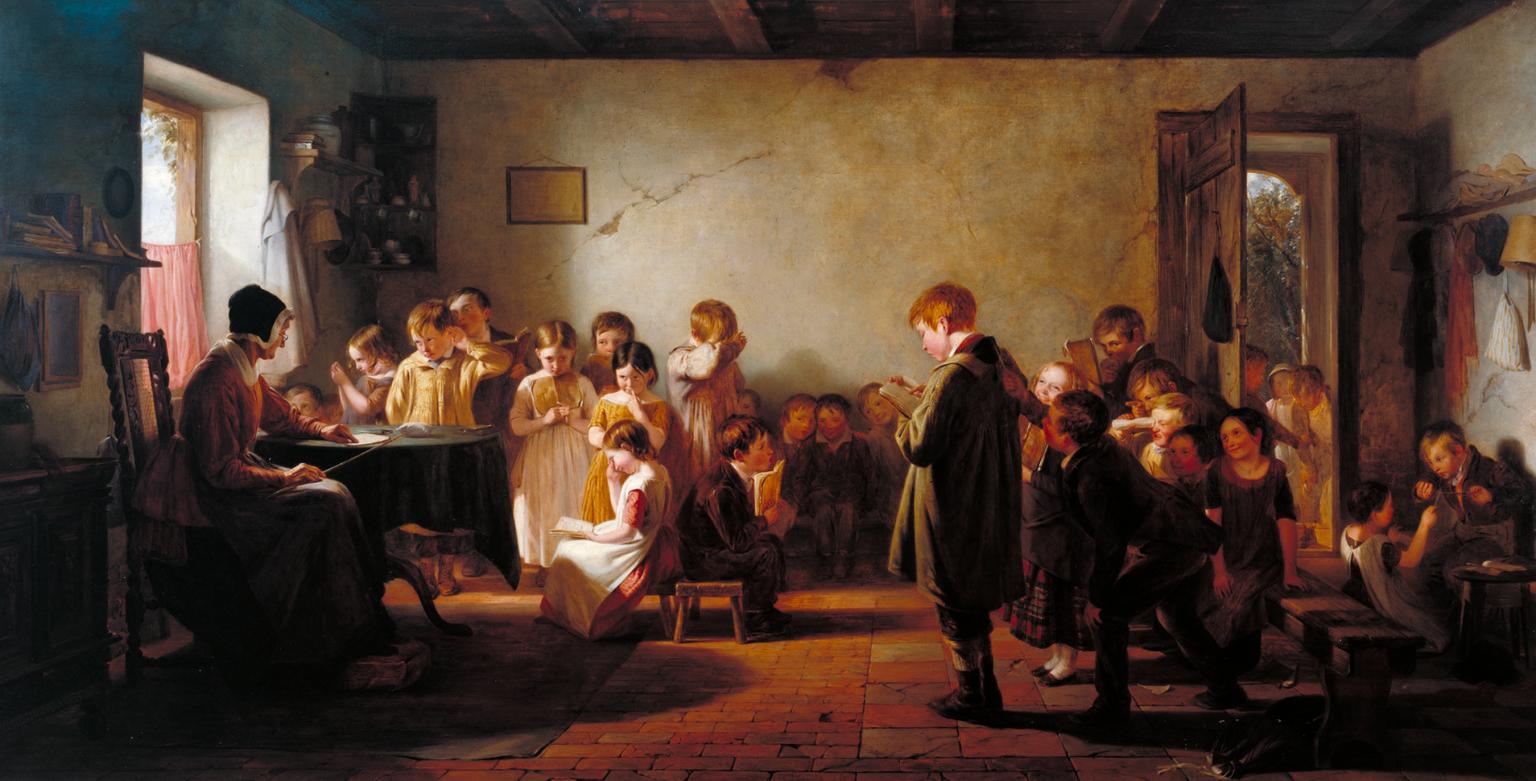 The
most common schools available for lower working class families in eighteenth-century
were dame schools. An elderly, barely literate, woman would teach reading and sewing for
a small fee. Read more in English Heritage’s brochure on England’s School. The
image of children learning in a dame school, painted by Thomas Webster (1845), is housed
in the Tate Art Museum, London.
- [FB]sentimental The sentimental novel is a genre which
rose into popularity in the eighteenth century. This genre is characterized by
excessively passionate characters, tearful scenes and dramatic, flowery dialogue. Mary
Wollstonecraft may be using the popularity of these novels among young women to explain
their apparent lack of rationality rather than claiming irrationality to be a naturally
female trait. Read more about the sentimental novel in
Encyclopedia Britannica.
- [ES]novelsAs novels became more accessible they
became more popular. Some believed that excessive exposure to fiction novels would cause
readers to lose touch with reality and identify with characters to the point of
mimicking dangerous or immoral behavior. Read more about a popular novel that was blamed
for youthful suicides in this article by Frank Furedi from
History Today. - [ES]ranks The different ranks of society in
England during the eighteenth century were not simply divided between the rich or poor.
According to the eighteenth-century writer Daniel Defoe, there were seven categories:
the great, the rich, the middle sort, the working trades, the country people, the poor,
and the miserable. The country still relied on agriculture and, although some still died
of hunger, there was usually enough food to go around. Trade was increasing and more men
and women acquired jobs in industry. However, wealth was unequally distributed, with
only 5% of the national income belonging to the general population. Read more in this
Encyclopedia Britannica entry for eighteenth-century
Britain, and the source of this annotation. - [MR]seraglio
The
most common schools available for lower working class families in eighteenth-century
were dame schools. An elderly, barely literate, woman would teach reading and sewing for
a small fee. Read more in English Heritage’s brochure on England’s School. The
image of children learning in a dame school, painted by Thomas Webster (1845), is housed
in the Tate Art Museum, London.
- [FB]sentimental The sentimental novel is a genre which
rose into popularity in the eighteenth century. This genre is characterized by
excessively passionate characters, tearful scenes and dramatic, flowery dialogue. Mary
Wollstonecraft may be using the popularity of these novels among young women to explain
their apparent lack of rationality rather than claiming irrationality to be a naturally
female trait. Read more about the sentimental novel in
Encyclopedia Britannica.
- [ES]novelsAs novels became more accessible they
became more popular. Some believed that excessive exposure to fiction novels would cause
readers to lose touch with reality and identify with characters to the point of
mimicking dangerous or immoral behavior. Read more about a popular novel that was blamed
for youthful suicides in this article by Frank Furedi from
History Today. - [ES]ranks The different ranks of society in
England during the eighteenth century were not simply divided between the rich or poor.
According to the eighteenth-century writer Daniel Defoe, there were seven categories:
the great, the rich, the middle sort, the working trades, the country people, the poor,
and the miserable. The country still relied on agriculture and, although some still died
of hunger, there was usually enough food to go around. Trade was increasing and more men
and women acquired jobs in industry. However, wealth was unequally distributed, with
only 5% of the national income belonging to the general population. Read more in this
Encyclopedia Britannica entry for eighteenth-century
Britain, and the source of this annotation. - [MR]seraglio
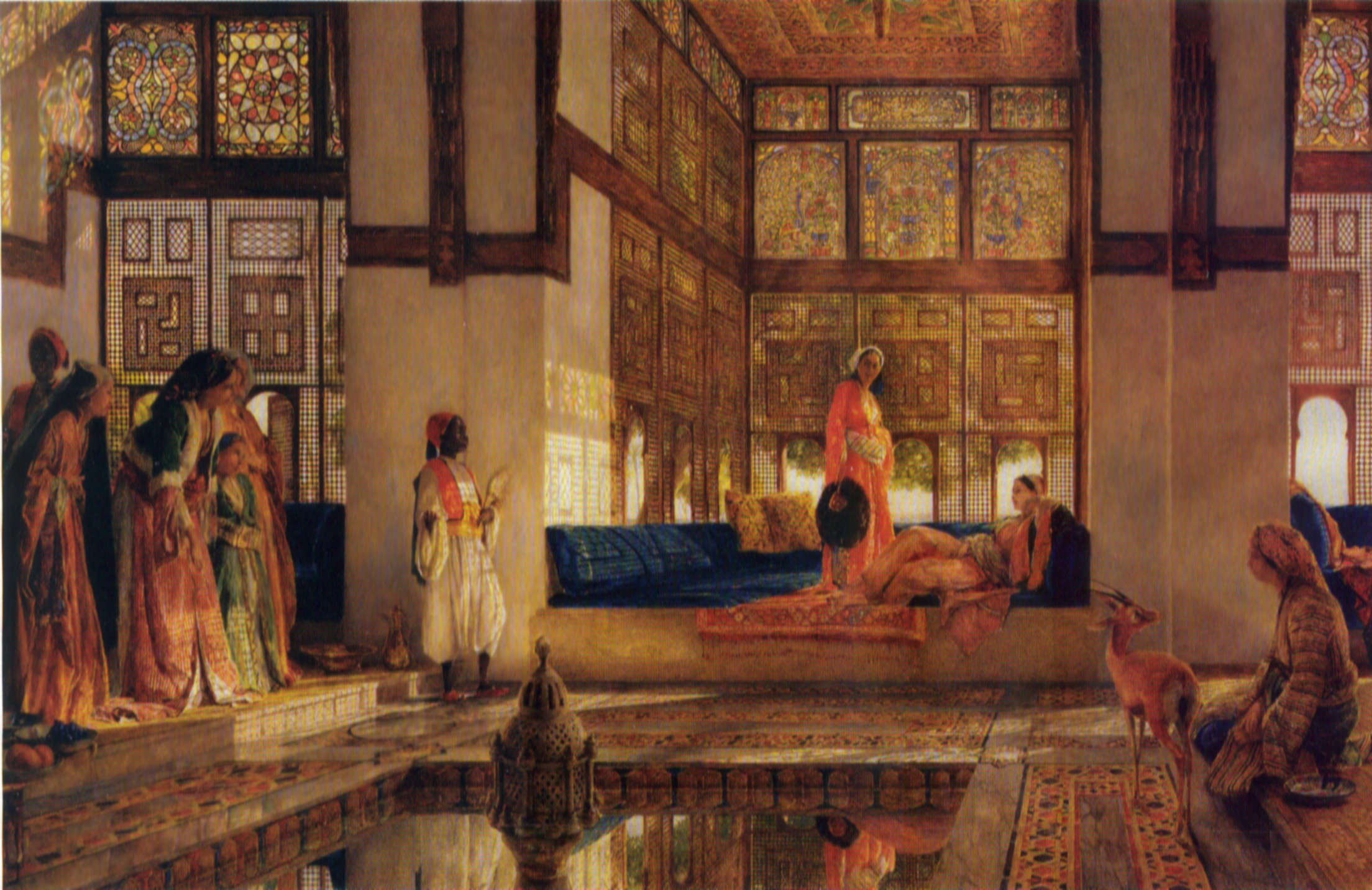 Wollstonecraft’s argument in A Vindication of the
Rights of Woman is that women spend most of their lives acquiring knowledge to
be perfect wives instead of strengthening their minds and bodies to place a man. Because
the only way women can rise the world is through marriage, they are being groomed to
become lovers much like women in a Turkish seraglio, as Susan Gubar notes in "Feminist
Misogyny" (Gubar
151). Wollstonecraft is pointing out the lack of freedom for women. The image
included here illustrates the women’s quarter of a seraglio painted in 1873 by John
Frederick Lewis. This image is from Wikimedia Commons.
- [RDJ]dress
Wollstonecraft’s argument in A Vindication of the
Rights of Woman is that women spend most of their lives acquiring knowledge to
be perfect wives instead of strengthening their minds and bodies to place a man. Because
the only way women can rise the world is through marriage, they are being groomed to
become lovers much like women in a Turkish seraglio, as Susan Gubar notes in "Feminist
Misogyny" (Gubar
151). Wollstonecraft is pointing out the lack of freedom for women. The image
included here illustrates the women’s quarter of a seraglio painted in 1873 by John
Frederick Lewis. This image is from Wikimedia Commons.
- [RDJ]dress
 In the eighteenth century, women were encouraged to focus on their
dress, meaning their overall attire, because as Dr. Gregory argues in A Father’s Legacy to His Daughters, it was supposedly natural
to them (55). Women were dressed in hope of catching the attention of a man;
they would parade, or flaunt themselves to men, hoping to find a husband, which is the
only way for a woman to "rise in the world," as Wollstonecraft notes above (9).
Wollstonecraft didn’t want women to dress and flaunt themselves only for men’s
attention; she wanted women to focus on their own education. This portrait of Madame
Pompadour, located in the Alte Pinkothek Museum in Munich and via Wikimedia Commons, provides an example of
women’s attire in the 1700s in which Wollstonecraft was advising them not to do. Learn
more about eighteenth-century fashion at the Victoria and Albert Museum. - [DF]governess According to Katheryn Hughes, the governess was one of the most familiar figures in the
Romantic period and throughout the Victorian period. Governesses were women who earned
their living by teaching and caring for other women’s children. Most governesses lived
with their employers and were paid a small salary on top of their board and lodging. The
governess was seen as an outsider, not quite fitting in with the family she governed for
but not exactly fitting in as a servant either. - [AH]manly
In the eighteenth century, women were encouraged to focus on their
dress, meaning their overall attire, because as Dr. Gregory argues in A Father’s Legacy to His Daughters, it was supposedly natural
to them (55). Women were dressed in hope of catching the attention of a man;
they would parade, or flaunt themselves to men, hoping to find a husband, which is the
only way for a woman to "rise in the world," as Wollstonecraft notes above (9).
Wollstonecraft didn’t want women to dress and flaunt themselves only for men’s
attention; she wanted women to focus on their own education. This portrait of Madame
Pompadour, located in the Alte Pinkothek Museum in Munich and via Wikimedia Commons, provides an example of
women’s attire in the 1700s in which Wollstonecraft was advising them not to do. Learn
more about eighteenth-century fashion at the Victoria and Albert Museum. - [DF]governess According to Katheryn Hughes, the governess was one of the most familiar figures in the
Romantic period and throughout the Victorian period. Governesses were women who earned
their living by teaching and caring for other women’s children. Most governesses lived
with their employers and were paid a small salary on top of their board and lodging. The
governess was seen as an outsider, not quite fitting in with the family she governed for
but not exactly fitting in as a servant either. - [AH]manly
 "Manly virtues" in the eighteenth century refers to social
behavior that encourages men to be kind, loving, and courageous both in the home and in
the public domain. Since masculinity is, as Intertextual War: Edmund
Burke and the French Revolution in the Writings of Mary Wollstonecraft, Thomas Paine,
and James Mackintosh by Steven Blakemore, states, a "restrictive misnomer for
qualities or virtues that are human," Mary Wollstonecraft opposes men that inveigh
against masculine women because of its imitation of manly virtues (Blakemore 42). The portrait here, Mr. and Mrs. Andrews
by Thomas Gainsborough (1748), is housed in the National Gallery London. This painting,
via Wikimedia Commons, illustrates manliness in terms of gentility. - [RB]phosphorus
"Manly virtues" in the eighteenth century refers to social
behavior that encourages men to be kind, loving, and courageous both in the home and in
the public domain. Since masculinity is, as Intertextual War: Edmund
Burke and the French Revolution in the Writings of Mary Wollstonecraft, Thomas Paine,
and James Mackintosh by Steven Blakemore, states, a "restrictive misnomer for
qualities or virtues that are human," Mary Wollstonecraft opposes men that inveigh
against masculine women because of its imitation of manly virtues (Blakemore 42). The portrait here, Mr. and Mrs. Andrews
by Thomas Gainsborough (1748), is housed in the National Gallery London. This painting,
via Wikimedia Commons, illustrates manliness in terms of gentility. - [RB]phosphorus
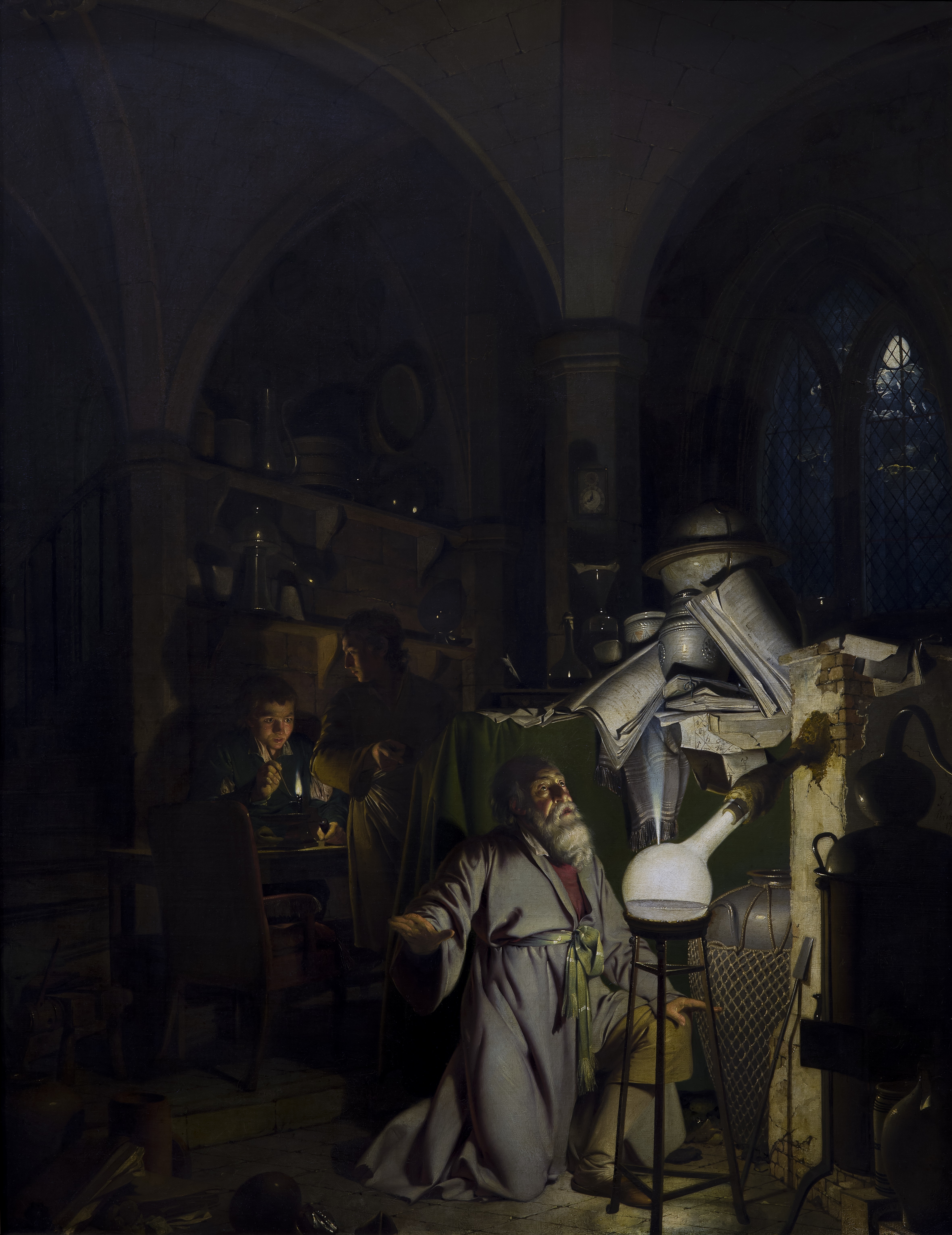 Used by alchemists throughout the seventeenth century, phosphorous was
officially designated the thirteenth element by Antoine Lavosier in 1777. Quack
physicians incorporated the eerily-glowing phosphorous into their "cure all" medicines.
Here, Wollstonecraft may be referring to a long-standing association between the element
and its use in false medicines as well as its generation of artificial light. The image
included here, The Alchymist, In Search of the Philosopher’s Stone,
Discovers Phosphorus (1770) is by Joseph Wright of Derby, via Wikimedia Commons. Read more about the discovery of phosphorus on the personal blog Res Obscura. - [TG]
Used by alchemists throughout the seventeenth century, phosphorous was
officially designated the thirteenth element by Antoine Lavosier in 1777. Quack
physicians incorporated the eerily-glowing phosphorous into their "cure all" medicines.
Here, Wollstonecraft may be referring to a long-standing association between the element
and its use in false medicines as well as its generation of artificial light. The image
included here, The Alchymist, In Search of the Philosopher’s Stone,
Discovers Phosphorus (1770) is by Joseph Wright of Derby, via Wikimedia Commons. Read more about the discovery of phosphorus on the personal blog Res Obscura. - [TG]
 Born in London on April 27, 1759, Mary Wollstonecraft is considered
one of the principal figures in modern feminism. Her works reflected her unmarried
middle class experience, emphasizing gender injustice, the failure of the education
system for young women, and the position of women in unhappy marriages. Her best known
work, Vindication of the Rights of Women (1792), argues that to
attain virtue, women need access to systemic education. See this biographical essay on Wollstonecraft by Janet Todd. The portrait of
Wollstonecraft included here, painted by John Opie (1797), is housed in the National Portrait Gallery, London. - [MUstudstaff]mahometanism
Born in London on April 27, 1759, Mary Wollstonecraft is considered
one of the principal figures in modern feminism. Her works reflected her unmarried
middle class experience, emphasizing gender injustice, the failure of the education
system for young women, and the position of women in unhappy marriages. Her best known
work, Vindication of the Rights of Women (1792), argues that to
attain virtue, women need access to systemic education. See this biographical essay on Wollstonecraft by Janet Todd. The portrait of
Wollstonecraft included here, painted by John Opie (1797), is housed in the National Portrait Gallery, London. - [MUstudstaff]mahometanism
 Source: 1848 lithograph by James Rattray showing an Afgan women under purdahA term used by Westerners to refer to Muslims, in this context
Mahometanism is associated with the limited opportunities and oppressed status of women
in the eighteenth century. As discussed in The
Feminization Debate in Eighteenth-Century England (2004) by E. Clery,
women were trained to obey their father and husband. This confinement and
domesticization was frequently described as "Mahometan" due to the misguided belief
among the English that Islam sees women as not possessing souls. Social reformer and
leader of the Blue Stockings Society, Elizabeth Montagu lamented in a letter about the
effects of such "Mahometan" belief, which is used to justify women's domestic
confinement (Clery 136). The image included here, an 1848 lithograph by James Rattray, shows
Afgan women under purdah. Image via
Wikimedia Commons. - [BT]education
Source: 1848 lithograph by James Rattray showing an Afgan women under purdahA term used by Westerners to refer to Muslims, in this context
Mahometanism is associated with the limited opportunities and oppressed status of women
in the eighteenth century. As discussed in The
Feminization Debate in Eighteenth-Century England (2004) by E. Clery,
women were trained to obey their father and husband. This confinement and
domesticization was frequently described as "Mahometan" due to the misguided belief
among the English that Islam sees women as not possessing souls. Social reformer and
leader of the Blue Stockings Society, Elizabeth Montagu lamented in a letter about the
effects of such "Mahometan" belief, which is used to justify women's domestic
confinement (Clery 136). The image included here, an 1848 lithograph by James Rattray, shows
Afgan women under purdah. Image via
Wikimedia Commons. - [BT]education
 Mary Wollstonecraft noted the absence of proficient education for
young women in the eighteenth century and decided to establish a school. Wollstonecraft,
along with her sister Eliza, and friend Fanny Blood, opened the school in 1784. The
school was established in Newington Green just outside of London. Although the school
closed from financial distress in 1785, Wollstonecraft drew from her experience as a
teacher and wrote Thoughts on the Education of Daughters with
Reflections on Female Conduct in the more important Duties of Life (1787). The
above picture shows a plaque dedicated to Mary Wollstonecraft at the Newington Green
Primary School near where the school was located in the 18th century. For more
information on the life of Mary Wollstonecraft, read this biographical essay
written by Sylvana Tomaselli. To look through a copy of Wollstonecraft's Thoughts on the Education of Daughters with Reflections on Female
Conduct in the more important Duties of Life click here for an
online version of the book from the London School of Economics’ digital library. - [NB]trifling_employments
Mary Wollstonecraft noted the absence of proficient education for
young women in the eighteenth century and decided to establish a school. Wollstonecraft,
along with her sister Eliza, and friend Fanny Blood, opened the school in 1784. The
school was established in Newington Green just outside of London. Although the school
closed from financial distress in 1785, Wollstonecraft drew from her experience as a
teacher and wrote Thoughts on the Education of Daughters with
Reflections on Female Conduct in the more important Duties of Life (1787). The
above picture shows a plaque dedicated to Mary Wollstonecraft at the Newington Green
Primary School near where the school was located in the 18th century. For more
information on the life of Mary Wollstonecraft, read this biographical essay
written by Sylvana Tomaselli. To look through a copy of Wollstonecraft's Thoughts on the Education of Daughters with Reflections on Female
Conduct in the more important Duties of Life click here for an
online version of the book from the London School of Economics’ digital library. - [NB]trifling_employments
 By "trifling employments," Wollstonecraft refers to the kinds of
things elegant women did to employ their time such as needlepoint. Not allowed to
participate in the masculine public sphere, women instead spent their time in domestic
labor and activities. Many were mothers and homemakers. These activities were not
masculine and serious but feminine and trifling. Read more on women’s work in the
eighteenth century in this article by
Susan E. Jones, also the source of this annotation. The portrait above, via the Frick
Collection, is a conversation piece by Joshua Reynolds (1723–1792) showing the
genteel young ladies Waldegrave engaged in such domestic work. - [MM]history This is likely a reference to
discussions about the hierarchy of genres during the eighteenth century. Dorothee Birke,
author of Writing the Reader: Configurations of Cultural Practice in English Novel
(2016), explains that historical and philosophical works were seen to have
higher value than novels and poetry. The reason behind such a hierarchical placement is
the perception of fictional reading to be connected with ignorance as people are fed
unrealistic words. Thus, historical and philosophical works which were often based on
truth and it reality, were insightful readings that were ranked higher than unrealistic
or exaggerated works (Birke 63). - [DN]sandford_merton Likely a reference to a popular
children’s book written in the eighteenth century, Sandford and
Merton (1783), by Thomas Day, is about two boys who grow up differently based on
social status. According to
Stephen Bending and Stephen Bygrave, the book is an indictment of upper class
"effete" masculinity (23). Tommy Merton is spoiled by middle class privileges and needs
to be re-educated to become as fine a man as Sandford, whose lower-class status
challenged him to develop, physically and mentally, into an admirable young man (3-4).
Interested viewers can also read an abridged
version of Day’s children’s book, published in 1792, at the Internet Archive. - [SV]novelistsWollstonecraft's question refers to an
ongoing discussion about the work of novel-reading on young girls' intellectual growth.
It was thought dangerous for women to read novels because society feared that they would
not, as Anna North writes in "When Novels Were Bad for You," be able to "differentiate between fiction and
life." - [KS]bubbled
By "trifling employments," Wollstonecraft refers to the kinds of
things elegant women did to employ their time such as needlepoint. Not allowed to
participate in the masculine public sphere, women instead spent their time in domestic
labor and activities. Many were mothers and homemakers. These activities were not
masculine and serious but feminine and trifling. Read more on women’s work in the
eighteenth century in this article by
Susan E. Jones, also the source of this annotation. The portrait above, via the Frick
Collection, is a conversation piece by Joshua Reynolds (1723–1792) showing the
genteel young ladies Waldegrave engaged in such domestic work. - [MM]history This is likely a reference to
discussions about the hierarchy of genres during the eighteenth century. Dorothee Birke,
author of Writing the Reader: Configurations of Cultural Practice in English Novel
(2016), explains that historical and philosophical works were seen to have
higher value than novels and poetry. The reason behind such a hierarchical placement is
the perception of fictional reading to be connected with ignorance as people are fed
unrealistic words. Thus, historical and philosophical works which were often based on
truth and it reality, were insightful readings that were ranked higher than unrealistic
or exaggerated works (Birke 63). - [DN]sandford_merton Likely a reference to a popular
children’s book written in the eighteenth century, Sandford and
Merton (1783), by Thomas Day, is about two boys who grow up differently based on
social status. According to
Stephen Bending and Stephen Bygrave, the book is an indictment of upper class
"effete" masculinity (23). Tommy Merton is spoiled by middle class privileges and needs
to be re-educated to become as fine a man as Sandford, whose lower-class status
challenged him to develop, physically and mentally, into an admirable young man (3-4).
Interested viewers can also read an abridged
version of Day’s children’s book, published in 1792, at the Internet Archive. - [SV]novelistsWollstonecraft's question refers to an
ongoing discussion about the work of novel-reading on young girls' intellectual growth.
It was thought dangerous for women to read novels because society feared that they would
not, as Anna North writes in "When Novels Were Bad for You," be able to "differentiate between fiction and
life." - [KS]bubbled
 According to the Oxford English Dictionary, in the eighteenth-century
the word "bubbled" meant befooled, cheated, or deceived. Here, Wollstonecraft is saying
women’s understandings have been fooled by the popularization and distribution of
conduct books and their false depiction of women. "Bubbled" in this usage is also
derived from the devastating financial bubble in the eighteenth century, including the
South Sea Bubble of 1720. Many engravings and satirical prints of the time depict how
the people were deceived and cheated financially, most notably, The
Bubbler’s Medley, or a Sketch of the Times being Europe’s Memoriam for 1720.
The image included here is from the British Museum's online collection. To read more, visit Harvard Business School’s
online exhibit on the South Sea Bubble, and the source of this annotation. - [JMF]conduct
According to the Oxford English Dictionary, in the eighteenth-century
the word "bubbled" meant befooled, cheated, or deceived. Here, Wollstonecraft is saying
women’s understandings have been fooled by the popularization and distribution of
conduct books and their false depiction of women. "Bubbled" in this usage is also
derived from the devastating financial bubble in the eighteenth century, including the
South Sea Bubble of 1720. Many engravings and satirical prints of the time depict how
the people were deceived and cheated financially, most notably, The
Bubbler’s Medley, or a Sketch of the Times being Europe’s Memoriam for 1720.
The image included here is from the British Museum's online collection. To read more, visit Harvard Business School’s
online exhibit on the South Sea Bubble, and the source of this annotation. - [JMF]conduct
 Source: The Title page of Gregory's conduct book
This is most likely a reference to Dr. John Gregory’s A Father’s Legacy to His Daughters, a conduct book written prior
to Dr. Gregory’s wife’s passing in 1761 and addressed to his daughters about etiquette,
religion, conduct, and behaviors. Wollstonecraft references this book directly in many
of her arguments. The image of the book's title page (1795) is from the University of Delaware Special Collections Department is from the National Library of Scotland. View a 1793 edition of A Father’s Legacy to His Daughters at the Internet
Archive. - [BT]johnson
Source: The Title page of Gregory's conduct book
This is most likely a reference to Dr. John Gregory’s A Father’s Legacy to His Daughters, a conduct book written prior
to Dr. Gregory’s wife’s passing in 1761 and addressed to his daughters about etiquette,
religion, conduct, and behaviors. Wollstonecraft references this book directly in many
of her arguments. The image of the book's title page (1795) is from the University of Delaware Special Collections Department is from the National Library of Scotland. View a 1793 edition of A Father’s Legacy to His Daughters at the Internet
Archive. - [BT]johnson
 Throughout the eighteenth century, St. Paul’s Church Yard was the center of the
publishing trade. Wollstonecraft's Vindications was published by
Joseph Johnson, a liberal publisher with radical views, who published work by William
Godwin, Joseph Priestly, and William Blake. Wollstonecraft lived near St. Paul’s Church
Yard and spent many hours in this workshop as Joseph Johnson gave her writing and
translating jobs throughout the day. For more on the relationship between Mary
Wollstonecraft and Joseph Johnson, see this letter from Wollstonecraft to her publisher reprinted in The
American Reader. The image here, from a University of Louisville news
article on William Shakespeare's first folio, shows the locations of printers around St.
Paul's during the late sixteenth and early seventeenth centuries. - [TH]elegance
Throughout the eighteenth century, St. Paul’s Church Yard was the center of the
publishing trade. Wollstonecraft's Vindications was published by
Joseph Johnson, a liberal publisher with radical views, who published work by William
Godwin, Joseph Priestly, and William Blake. Wollstonecraft lived near St. Paul’s Church
Yard and spent many hours in this workshop as Joseph Johnson gave her writing and
translating jobs throughout the day. For more on the relationship between Mary
Wollstonecraft and Joseph Johnson, see this letter from Wollstonecraft to her publisher reprinted in The
American Reader. The image here, from a University of Louisville news
article on William Shakespeare's first folio, shows the locations of printers around St.
Paul's during the late sixteenth and early seventeenth centuries. - [TH]elegance
 Elegance in the 18th century has a specific meaning when applied to
women. According to Robert
W. Jones, author of Gender and the Formation of Taste in
Eighteenth-Century Britain, feminine elegance is the combination of
docility and enticement of men. In the eighteenth century, elegance is feminized with
the goal that women should use it to please and seduce men through beauty and
refinement. Elegance of the eighteenth century is the area of the pleasing and amiable
actions from women to men, these beauty standards were important and a source of
intrigue for the culture (Jones 109). The image here, drawn from the National Gallery of
Art in Washington, DC, shows An Elegant Lady Playing a Cittern (1770), by Nathaniel
Dance-Holland. - [SM]virtue Mary Wollstonecraft uses "virtue" with
its eighteenth-century sense of power. Men were often seen as virtuous because of their
physical strength, whereas women acquired virtue through sensibility and virginity.
Wollstonecraft argues that true virtue can only exist with knowledge and education.
Therefore, women must be properly educated or they would only be mimicking true virtue.
Views of Women in
Eighteenth Century Literature," published in the International
Journal of Communication Research by Adrian Brunello and Florina-Elena
Borsan reviews the way that understandings of womanhood shifted in the period, resulting
in the need for an exterior display of virtue, rather than true virtue (325-326). clicking here will direct you to the UK National Gallery of Art, showing An Allegory of Virtue and Riches, painted in 1667 by Godfried
Schalcken.
- [RB]schools
Elegance in the 18th century has a specific meaning when applied to
women. According to Robert
W. Jones, author of Gender and the Formation of Taste in
Eighteenth-Century Britain, feminine elegance is the combination of
docility and enticement of men. In the eighteenth century, elegance is feminized with
the goal that women should use it to please and seduce men through beauty and
refinement. Elegance of the eighteenth century is the area of the pleasing and amiable
actions from women to men, these beauty standards were important and a source of
intrigue for the culture (Jones 109). The image here, drawn from the National Gallery of
Art in Washington, DC, shows An Elegant Lady Playing a Cittern (1770), by Nathaniel
Dance-Holland. - [SM]virtue Mary Wollstonecraft uses "virtue" with
its eighteenth-century sense of power. Men were often seen as virtuous because of their
physical strength, whereas women acquired virtue through sensibility and virginity.
Wollstonecraft argues that true virtue can only exist with knowledge and education.
Therefore, women must be properly educated or they would only be mimicking true virtue.
Views of Women in
Eighteenth Century Literature," published in the International
Journal of Communication Research by Adrian Brunello and Florina-Elena
Borsan reviews the way that understandings of womanhood shifted in the period, resulting
in the need for an exterior display of virtue, rather than true virtue (325-326). clicking here will direct you to the UK National Gallery of Art, showing An Allegory of Virtue and Riches, painted in 1667 by Godfried
Schalcken.
- [RB]schools
 The
most common schools available for lower working class families in eighteenth-century
were dame schools. An elderly, barely literate, woman would teach reading and sewing for
a small fee. Read more in English Heritage’s brochure on England’s School. The
image of children learning in a dame school, painted by Thomas Webster (1845), is housed
in the Tate Art Museum, London.
- [FB]sentimental The sentimental novel is a genre which
rose into popularity in the eighteenth century. This genre is characterized by
excessively passionate characters, tearful scenes and dramatic, flowery dialogue. Mary
Wollstonecraft may be using the popularity of these novels among young women to explain
their apparent lack of rationality rather than claiming irrationality to be a naturally
female trait. Read more about the sentimental novel in
Encyclopedia Britannica.
- [ES]novelsAs novels became more accessible they
became more popular. Some believed that excessive exposure to fiction novels would cause
readers to lose touch with reality and identify with characters to the point of
mimicking dangerous or immoral behavior. Read more about a popular novel that was blamed
for youthful suicides in this article by Frank Furedi from
History Today. - [ES]ranks The different ranks of society in
England during the eighteenth century were not simply divided between the rich or poor.
According to the eighteenth-century writer Daniel Defoe, there were seven categories:
the great, the rich, the middle sort, the working trades, the country people, the poor,
and the miserable. The country still relied on agriculture and, although some still died
of hunger, there was usually enough food to go around. Trade was increasing and more men
and women acquired jobs in industry. However, wealth was unequally distributed, with
only 5% of the national income belonging to the general population. Read more in this
Encyclopedia Britannica entry for eighteenth-century
Britain, and the source of this annotation. - [MR]seraglio
The
most common schools available for lower working class families in eighteenth-century
were dame schools. An elderly, barely literate, woman would teach reading and sewing for
a small fee. Read more in English Heritage’s brochure on England’s School. The
image of children learning in a dame school, painted by Thomas Webster (1845), is housed
in the Tate Art Museum, London.
- [FB]sentimental The sentimental novel is a genre which
rose into popularity in the eighteenth century. This genre is characterized by
excessively passionate characters, tearful scenes and dramatic, flowery dialogue. Mary
Wollstonecraft may be using the popularity of these novels among young women to explain
their apparent lack of rationality rather than claiming irrationality to be a naturally
female trait. Read more about the sentimental novel in
Encyclopedia Britannica.
- [ES]novelsAs novels became more accessible they
became more popular. Some believed that excessive exposure to fiction novels would cause
readers to lose touch with reality and identify with characters to the point of
mimicking dangerous or immoral behavior. Read more about a popular novel that was blamed
for youthful suicides in this article by Frank Furedi from
History Today. - [ES]ranks The different ranks of society in
England during the eighteenth century were not simply divided between the rich or poor.
According to the eighteenth-century writer Daniel Defoe, there were seven categories:
the great, the rich, the middle sort, the working trades, the country people, the poor,
and the miserable. The country still relied on agriculture and, although some still died
of hunger, there was usually enough food to go around. Trade was increasing and more men
and women acquired jobs in industry. However, wealth was unequally distributed, with
only 5% of the national income belonging to the general population. Read more in this
Encyclopedia Britannica entry for eighteenth-century
Britain, and the source of this annotation. - [MR]seraglio
 Wollstonecraft’s argument in A Vindication of the
Rights of Woman is that women spend most of their lives acquiring knowledge to
be perfect wives instead of strengthening their minds and bodies to place a man. Because
the only way women can rise the world is through marriage, they are being groomed to
become lovers much like women in a Turkish seraglio, as Susan Gubar notes in "Feminist
Misogyny" (Gubar
151). Wollstonecraft is pointing out the lack of freedom for women. The image
included here illustrates the women’s quarter of a seraglio painted in 1873 by John
Frederick Lewis. This image is from Wikimedia Commons.
- [RDJ]dress
Wollstonecraft’s argument in A Vindication of the
Rights of Woman is that women spend most of their lives acquiring knowledge to
be perfect wives instead of strengthening their minds and bodies to place a man. Because
the only way women can rise the world is through marriage, they are being groomed to
become lovers much like women in a Turkish seraglio, as Susan Gubar notes in "Feminist
Misogyny" (Gubar
151). Wollstonecraft is pointing out the lack of freedom for women. The image
included here illustrates the women’s quarter of a seraglio painted in 1873 by John
Frederick Lewis. This image is from Wikimedia Commons.
- [RDJ]dress
 In the eighteenth century, women were encouraged to focus on their
dress, meaning their overall attire, because as Dr. Gregory argues in A Father’s Legacy to His Daughters, it was supposedly natural
to them (55). Women were dressed in hope of catching the attention of a man;
they would parade, or flaunt themselves to men, hoping to find a husband, which is the
only way for a woman to "rise in the world," as Wollstonecraft notes above (9).
Wollstonecraft didn’t want women to dress and flaunt themselves only for men’s
attention; she wanted women to focus on their own education. This portrait of Madame
Pompadour, located in the Alte Pinkothek Museum in Munich and via Wikimedia Commons, provides an example of
women’s attire in the 1700s in which Wollstonecraft was advising them not to do. Learn
more about eighteenth-century fashion at the Victoria and Albert Museum. - [DF]governess According to Katheryn Hughes, the governess was one of the most familiar figures in the
Romantic period and throughout the Victorian period. Governesses were women who earned
their living by teaching and caring for other women’s children. Most governesses lived
with their employers and were paid a small salary on top of their board and lodging. The
governess was seen as an outsider, not quite fitting in with the family she governed for
but not exactly fitting in as a servant either. - [AH]manly
In the eighteenth century, women were encouraged to focus on their
dress, meaning their overall attire, because as Dr. Gregory argues in A Father’s Legacy to His Daughters, it was supposedly natural
to them (55). Women were dressed in hope of catching the attention of a man;
they would parade, or flaunt themselves to men, hoping to find a husband, which is the
only way for a woman to "rise in the world," as Wollstonecraft notes above (9).
Wollstonecraft didn’t want women to dress and flaunt themselves only for men’s
attention; she wanted women to focus on their own education. This portrait of Madame
Pompadour, located in the Alte Pinkothek Museum in Munich and via Wikimedia Commons, provides an example of
women’s attire in the 1700s in which Wollstonecraft was advising them not to do. Learn
more about eighteenth-century fashion at the Victoria and Albert Museum. - [DF]governess According to Katheryn Hughes, the governess was one of the most familiar figures in the
Romantic period and throughout the Victorian period. Governesses were women who earned
their living by teaching and caring for other women’s children. Most governesses lived
with their employers and were paid a small salary on top of their board and lodging. The
governess was seen as an outsider, not quite fitting in with the family she governed for
but not exactly fitting in as a servant either. - [AH]manly
 "Manly virtues" in the eighteenth century refers to social
behavior that encourages men to be kind, loving, and courageous both in the home and in
the public domain. Since masculinity is, as Intertextual War: Edmund
Burke and the French Revolution in the Writings of Mary Wollstonecraft, Thomas Paine,
and James Mackintosh by Steven Blakemore, states, a "restrictive misnomer for
qualities or virtues that are human," Mary Wollstonecraft opposes men that inveigh
against masculine women because of its imitation of manly virtues (Blakemore 42). The portrait here, Mr. and Mrs. Andrews
by Thomas Gainsborough (1748), is housed in the National Gallery London. This painting,
via Wikimedia Commons, illustrates manliness in terms of gentility. - [RB]phosphorus
"Manly virtues" in the eighteenth century refers to social
behavior that encourages men to be kind, loving, and courageous both in the home and in
the public domain. Since masculinity is, as Intertextual War: Edmund
Burke and the French Revolution in the Writings of Mary Wollstonecraft, Thomas Paine,
and James Mackintosh by Steven Blakemore, states, a "restrictive misnomer for
qualities or virtues that are human," Mary Wollstonecraft opposes men that inveigh
against masculine women because of its imitation of manly virtues (Blakemore 42). The portrait here, Mr. and Mrs. Andrews
by Thomas Gainsborough (1748), is housed in the National Gallery London. This painting,
via Wikimedia Commons, illustrates manliness in terms of gentility. - [RB]phosphorus
 Used by alchemists throughout the seventeenth century, phosphorous was
officially designated the thirteenth element by Antoine Lavosier in 1777. Quack
physicians incorporated the eerily-glowing phosphorous into their "cure all" medicines.
Here, Wollstonecraft may be referring to a long-standing association between the element
and its use in false medicines as well as its generation of artificial light. The image
included here, The Alchymist, In Search of the Philosopher’s Stone,
Discovers Phosphorus (1770) is by Joseph Wright of Derby, via Wikimedia Commons. Read more about the discovery of phosphorus on the personal blog Res Obscura. - [TG]
Used by alchemists throughout the seventeenth century, phosphorous was
officially designated the thirteenth element by Antoine Lavosier in 1777. Quack
physicians incorporated the eerily-glowing phosphorous into their "cure all" medicines.
Here, Wollstonecraft may be referring to a long-standing association between the element
and its use in false medicines as well as its generation of artificial light. The image
included here, The Alchymist, In Search of the Philosopher’s Stone,
Discovers Phosphorus (1770) is by Joseph Wright of Derby, via Wikimedia Commons. Read more about the discovery of phosphorus on the personal blog Res Obscura. - [TG][TP]
A
VINDICATION
OF THE
RIGHTS OF WOMAN:
WITH
STRICTURES
ON
POLITICAL AND MORAL SUBJECTS
BY MARY WOLLSTONECRAFTwollstonecraft
LONDON:
PRINTED FOR J. JOHNSON, No.71, ST. PAUL’S CHURCH YARD.johnson
1792.
A
VINDICATION
OF THE
RIGHTS OF WOMAN:
WITH
STRICTURES
ON
POLITICAL AND MORAL SUBJECTS
BY MARY WOLLSTONECRAFTwollstonecraft
LONDON:
PRINTED FOR J. JOHNSON, No.71, ST. PAUL’S CHURCH YARD.johnson
1792.
Footnotes
wollstonecraft_
 Born in London on April 27, 1759, Mary Wollstonecraft is considered
one of the principal figures in modern feminism. Her works reflected her unmarried
middle class experience, emphasizing gender injustice, the failure of the education
system for young women, and the position of women in unhappy marriages. Her best known
work, Vindication of the Rights of Women (1792), argues that to
attain virtue, women need access to systemic education. See this biographical essay on Wollstonecraft by Janet Todd. The portrait of
Wollstonecraft included here, painted by John Opie (1797), is housed in the National Portrait Gallery, London.
Born in London on April 27, 1759, Mary Wollstonecraft is considered
one of the principal figures in modern feminism. Her works reflected her unmarried
middle class experience, emphasizing gender injustice, the failure of the education
system for young women, and the position of women in unhappy marriages. Her best known
work, Vindication of the Rights of Women (1792), argues that to
attain virtue, women need access to systemic education. See this biographical essay on Wollstonecraft by Janet Todd. The portrait of
Wollstonecraft included here, painted by John Opie (1797), is housed in the National Portrait Gallery, London.
 Born in London on April 27, 1759, Mary Wollstonecraft is considered
one of the principal figures in modern feminism. Her works reflected her unmarried
middle class experience, emphasizing gender injustice, the failure of the education
system for young women, and the position of women in unhappy marriages. Her best known
work, Vindication of the Rights of Women (1792), argues that to
attain virtue, women need access to systemic education. See this biographical essay on Wollstonecraft by Janet Todd. The portrait of
Wollstonecraft included here, painted by John Opie (1797), is housed in the National Portrait Gallery, London.
Born in London on April 27, 1759, Mary Wollstonecraft is considered
one of the principal figures in modern feminism. Her works reflected her unmarried
middle class experience, emphasizing gender injustice, the failure of the education
system for young women, and the position of women in unhappy marriages. Her best known
work, Vindication of the Rights of Women (1792), argues that to
attain virtue, women need access to systemic education. See this biographical essay on Wollstonecraft by Janet Todd. The portrait of
Wollstonecraft included here, painted by John Opie (1797), is housed in the National Portrait Gallery, London. mahometanism_
 Source: 1848 lithograph by James Rattray showing an Afgan women under purdahA term used by Westerners to refer to Muslims, in this context
Mahometanism is associated with the limited opportunities and oppressed status of women
in the eighteenth century. As discussed in The
Feminization Debate in Eighteenth-Century England (2004) by E. Clery,
women were trained to obey their father and husband. This confinement and
domesticization was frequently described as "Mahometan" due to the misguided belief
among the English that Islam sees women as not possessing souls. Social reformer and
leader of the Blue Stockings Society, Elizabeth Montagu lamented in a letter about the
effects of such "Mahometan" belief, which is used to justify women's domestic
confinement (Clery 136). The image included here, an 1848 lithograph by James Rattray, shows
Afgan women under purdah. Image via
Wikimedia Commons.
Source: 1848 lithograph by James Rattray showing an Afgan women under purdahA term used by Westerners to refer to Muslims, in this context
Mahometanism is associated with the limited opportunities and oppressed status of women
in the eighteenth century. As discussed in The
Feminization Debate in Eighteenth-Century England (2004) by E. Clery,
women were trained to obey their father and husband. This confinement and
domesticization was frequently described as "Mahometan" due to the misguided belief
among the English that Islam sees women as not possessing souls. Social reformer and
leader of the Blue Stockings Society, Elizabeth Montagu lamented in a letter about the
effects of such "Mahometan" belief, which is used to justify women's domestic
confinement (Clery 136). The image included here, an 1848 lithograph by James Rattray, shows
Afgan women under purdah. Image via
Wikimedia Commons.
 Source: 1848 lithograph by James Rattray showing an Afgan women under purdahA term used by Westerners to refer to Muslims, in this context
Mahometanism is associated with the limited opportunities and oppressed status of women
in the eighteenth century. As discussed in The
Feminization Debate in Eighteenth-Century England (2004) by E. Clery,
women were trained to obey their father and husband. This confinement and
domesticization was frequently described as "Mahometan" due to the misguided belief
among the English that Islam sees women as not possessing souls. Social reformer and
leader of the Blue Stockings Society, Elizabeth Montagu lamented in a letter about the
effects of such "Mahometan" belief, which is used to justify women's domestic
confinement (Clery 136). The image included here, an 1848 lithograph by James Rattray, shows
Afgan women under purdah. Image via
Wikimedia Commons.
Source: 1848 lithograph by James Rattray showing an Afgan women under purdahA term used by Westerners to refer to Muslims, in this context
Mahometanism is associated with the limited opportunities and oppressed status of women
in the eighteenth century. As discussed in The
Feminization Debate in Eighteenth-Century England (2004) by E. Clery,
women were trained to obey their father and husband. This confinement and
domesticization was frequently described as "Mahometan" due to the misguided belief
among the English that Islam sees women as not possessing souls. Social reformer and
leader of the Blue Stockings Society, Elizabeth Montagu lamented in a letter about the
effects of such "Mahometan" belief, which is used to justify women's domestic
confinement (Clery 136). The image included here, an 1848 lithograph by James Rattray, shows
Afgan women under purdah. Image via
Wikimedia Commons.education_
 Mary Wollstonecraft noted the absence of proficient education for
young women in the eighteenth century and decided to establish a school. Wollstonecraft,
along with her sister Eliza, and friend Fanny Blood, opened the school in 1784. The
school was established in Newington Green just outside of London. Although the school
closed from financial distress in 1785, Wollstonecraft drew from her experience as a
teacher and wrote Thoughts on the Education of Daughters with
Reflections on Female Conduct in the more important Duties of Life (1787). The
above picture shows a plaque dedicated to Mary Wollstonecraft at the Newington Green
Primary School near where the school was located in the 18th century. For more
information on the life of Mary Wollstonecraft, read this biographical essay
written by Sylvana Tomaselli. To look through a copy of Wollstonecraft's Thoughts on the Education of Daughters with Reflections on Female
Conduct in the more important Duties of Life click here for an
online version of the book from the London School of Economics’ digital library.
Mary Wollstonecraft noted the absence of proficient education for
young women in the eighteenth century and decided to establish a school. Wollstonecraft,
along with her sister Eliza, and friend Fanny Blood, opened the school in 1784. The
school was established in Newington Green just outside of London. Although the school
closed from financial distress in 1785, Wollstonecraft drew from her experience as a
teacher and wrote Thoughts on the Education of Daughters with
Reflections on Female Conduct in the more important Duties of Life (1787). The
above picture shows a plaque dedicated to Mary Wollstonecraft at the Newington Green
Primary School near where the school was located in the 18th century. For more
information on the life of Mary Wollstonecraft, read this biographical essay
written by Sylvana Tomaselli. To look through a copy of Wollstonecraft's Thoughts on the Education of Daughters with Reflections on Female
Conduct in the more important Duties of Life click here for an
online version of the book from the London School of Economics’ digital library.
 Mary Wollstonecraft noted the absence of proficient education for
young women in the eighteenth century and decided to establish a school. Wollstonecraft,
along with her sister Eliza, and friend Fanny Blood, opened the school in 1784. The
school was established in Newington Green just outside of London. Although the school
closed from financial distress in 1785, Wollstonecraft drew from her experience as a
teacher and wrote Thoughts on the Education of Daughters with
Reflections on Female Conduct in the more important Duties of Life (1787). The
above picture shows a plaque dedicated to Mary Wollstonecraft at the Newington Green
Primary School near where the school was located in the 18th century. For more
information on the life of Mary Wollstonecraft, read this biographical essay
written by Sylvana Tomaselli. To look through a copy of Wollstonecraft's Thoughts on the Education of Daughters with Reflections on Female
Conduct in the more important Duties of Life click here for an
online version of the book from the London School of Economics’ digital library.
Mary Wollstonecraft noted the absence of proficient education for
young women in the eighteenth century and decided to establish a school. Wollstonecraft,
along with her sister Eliza, and friend Fanny Blood, opened the school in 1784. The
school was established in Newington Green just outside of London. Although the school
closed from financial distress in 1785, Wollstonecraft drew from her experience as a
teacher and wrote Thoughts on the Education of Daughters with
Reflections on Female Conduct in the more important Duties of Life (1787). The
above picture shows a plaque dedicated to Mary Wollstonecraft at the Newington Green
Primary School near where the school was located in the 18th century. For more
information on the life of Mary Wollstonecraft, read this biographical essay
written by Sylvana Tomaselli. To look through a copy of Wollstonecraft's Thoughts on the Education of Daughters with Reflections on Female
Conduct in the more important Duties of Life click here for an
online version of the book from the London School of Economics’ digital library. trifling_employments_
 By "trifling employments," Wollstonecraft refers to the kinds of
things elegant women did to employ their time such as needlepoint. Not allowed to
participate in the masculine public sphere, women instead spent their time in domestic
labor and activities. Many were mothers and homemakers. These activities were not
masculine and serious but feminine and trifling. Read more on women’s work in the
eighteenth century in this article by
Susan E. Jones, also the source of this annotation. The portrait above, via the Frick
Collection, is a conversation piece by Joshua Reynolds (1723–1792) showing the
genteel young ladies Waldegrave engaged in such domestic work.
By "trifling employments," Wollstonecraft refers to the kinds of
things elegant women did to employ their time such as needlepoint. Not allowed to
participate in the masculine public sphere, women instead spent their time in domestic
labor and activities. Many were mothers and homemakers. These activities were not
masculine and serious but feminine and trifling. Read more on women’s work in the
eighteenth century in this article by
Susan E. Jones, also the source of this annotation. The portrait above, via the Frick
Collection, is a conversation piece by Joshua Reynolds (1723–1792) showing the
genteel young ladies Waldegrave engaged in such domestic work.
 By "trifling employments," Wollstonecraft refers to the kinds of
things elegant women did to employ their time such as needlepoint. Not allowed to
participate in the masculine public sphere, women instead spent their time in domestic
labor and activities. Many were mothers and homemakers. These activities were not
masculine and serious but feminine and trifling. Read more on women’s work in the
eighteenth century in this article by
Susan E. Jones, also the source of this annotation. The portrait above, via the Frick
Collection, is a conversation piece by Joshua Reynolds (1723–1792) showing the
genteel young ladies Waldegrave engaged in such domestic work.
By "trifling employments," Wollstonecraft refers to the kinds of
things elegant women did to employ their time such as needlepoint. Not allowed to
participate in the masculine public sphere, women instead spent their time in domestic
labor and activities. Many were mothers and homemakers. These activities were not
masculine and serious but feminine and trifling. Read more on women’s work in the
eighteenth century in this article by
Susan E. Jones, also the source of this annotation. The portrait above, via the Frick
Collection, is a conversation piece by Joshua Reynolds (1723–1792) showing the
genteel young ladies Waldegrave engaged in such domestic work. history_ This is likely a reference to
discussions about the hierarchy of genres during the eighteenth century. Dorothee Birke,
author of Writing the Reader: Configurations of Cultural Practice in English Novel
(2016), explains that historical and philosophical works were seen to have
higher value than novels and poetry. The reason behind such a hierarchical placement is
the perception of fictional reading to be connected with ignorance as people are fed
unrealistic words. Thus, historical and philosophical works which were often based on
truth and it reality, were insightful readings that were ranked higher than unrealistic
or exaggerated works (Birke 63).
sandford_merton_ Likely a reference to a popular
children’s book written in the eighteenth century, Sandford and
Merton (1783), by Thomas Day, is about two boys who grow up differently based on
social status. According to
Stephen Bending and Stephen Bygrave, the book is an indictment of upper class
"effete" masculinity (23). Tommy Merton is spoiled by middle class privileges and needs
to be re-educated to become as fine a man as Sandford, whose lower-class status
challenged him to develop, physically and mentally, into an admirable young man (3-4).
Interested viewers can also read an abridged
version of Day’s children’s book, published in 1792, at the Internet Archive.
novelists_Wollstonecraft's question refers to an
ongoing discussion about the work of novel-reading on young girls' intellectual growth.
It was thought dangerous for women to read novels because society feared that they would
not, as Anna North writes in "When Novels Were Bad for You," be able to "differentiate between fiction and
life."
bubbled_
 According to the Oxford English Dictionary, in the eighteenth-century
the word "bubbled" meant befooled, cheated, or deceived. Here, Wollstonecraft is saying
women’s understandings have been fooled by the popularization and distribution of
conduct books and their false depiction of women. "Bubbled" in this usage is also
derived from the devastating financial bubble in the eighteenth century, including the
South Sea Bubble of 1720. Many engravings and satirical prints of the time depict how
the people were deceived and cheated financially, most notably, The
Bubbler’s Medley, or a Sketch of the Times being Europe’s Memoriam for 1720.
The image included here is from the British Museum's online collection. To read more, visit Harvard Business School’s
online exhibit on the South Sea Bubble, and the source of this annotation.
According to the Oxford English Dictionary, in the eighteenth-century
the word "bubbled" meant befooled, cheated, or deceived. Here, Wollstonecraft is saying
women’s understandings have been fooled by the popularization and distribution of
conduct books and their false depiction of women. "Bubbled" in this usage is also
derived from the devastating financial bubble in the eighteenth century, including the
South Sea Bubble of 1720. Many engravings and satirical prints of the time depict how
the people were deceived and cheated financially, most notably, The
Bubbler’s Medley, or a Sketch of the Times being Europe’s Memoriam for 1720.
The image included here is from the British Museum's online collection. To read more, visit Harvard Business School’s
online exhibit on the South Sea Bubble, and the source of this annotation.
 According to the Oxford English Dictionary, in the eighteenth-century
the word "bubbled" meant befooled, cheated, or deceived. Here, Wollstonecraft is saying
women’s understandings have been fooled by the popularization and distribution of
conduct books and their false depiction of women. "Bubbled" in this usage is also
derived from the devastating financial bubble in the eighteenth century, including the
South Sea Bubble of 1720. Many engravings and satirical prints of the time depict how
the people were deceived and cheated financially, most notably, The
Bubbler’s Medley, or a Sketch of the Times being Europe’s Memoriam for 1720.
The image included here is from the British Museum's online collection. To read more, visit Harvard Business School’s
online exhibit on the South Sea Bubble, and the source of this annotation.
According to the Oxford English Dictionary, in the eighteenth-century
the word "bubbled" meant befooled, cheated, or deceived. Here, Wollstonecraft is saying
women’s understandings have been fooled by the popularization and distribution of
conduct books and their false depiction of women. "Bubbled" in this usage is also
derived from the devastating financial bubble in the eighteenth century, including the
South Sea Bubble of 1720. Many engravings and satirical prints of the time depict how
the people were deceived and cheated financially, most notably, The
Bubbler’s Medley, or a Sketch of the Times being Europe’s Memoriam for 1720.
The image included here is from the British Museum's online collection. To read more, visit Harvard Business School’s
online exhibit on the South Sea Bubble, and the source of this annotation. conduct_
 Source: The Title page of Gregory's conduct book
This is most likely a reference to Dr. John Gregory’s A Father’s Legacy to His Daughters, a conduct book written prior
to Dr. Gregory’s wife’s passing in 1761 and addressed to his daughters about etiquette,
religion, conduct, and behaviors. Wollstonecraft references this book directly in many
of her arguments. The image of the book's title page (1795) is from the University of Delaware Special Collections Department is from the National Library of Scotland. View a 1793 edition of A Father’s Legacy to His Daughters at the Internet
Archive.
Source: The Title page of Gregory's conduct book
This is most likely a reference to Dr. John Gregory’s A Father’s Legacy to His Daughters, a conduct book written prior
to Dr. Gregory’s wife’s passing in 1761 and addressed to his daughters about etiquette,
religion, conduct, and behaviors. Wollstonecraft references this book directly in many
of her arguments. The image of the book's title page (1795) is from the University of Delaware Special Collections Department is from the National Library of Scotland. View a 1793 edition of A Father’s Legacy to His Daughters at the Internet
Archive.
 Source: The Title page of Gregory's conduct book
This is most likely a reference to Dr. John Gregory’s A Father’s Legacy to His Daughters, a conduct book written prior
to Dr. Gregory’s wife’s passing in 1761 and addressed to his daughters about etiquette,
religion, conduct, and behaviors. Wollstonecraft references this book directly in many
of her arguments. The image of the book's title page (1795) is from the University of Delaware Special Collections Department is from the National Library of Scotland. View a 1793 edition of A Father’s Legacy to His Daughters at the Internet
Archive.
Source: The Title page of Gregory's conduct book
This is most likely a reference to Dr. John Gregory’s A Father’s Legacy to His Daughters, a conduct book written prior
to Dr. Gregory’s wife’s passing in 1761 and addressed to his daughters about etiquette,
religion, conduct, and behaviors. Wollstonecraft references this book directly in many
of her arguments. The image of the book's title page (1795) is from the University of Delaware Special Collections Department is from the National Library of Scotland. View a 1793 edition of A Father’s Legacy to His Daughters at the Internet
Archive.johnson_
 Throughout the eighteenth century, St. Paul’s Church Yard was the center of the
publishing trade. Wollstonecraft's Vindications was published by
Joseph Johnson, a liberal publisher with radical views, who published work by William
Godwin, Joseph Priestly, and William Blake. Wollstonecraft lived near St. Paul’s Church
Yard and spent many hours in this workshop as Joseph Johnson gave her writing and
translating jobs throughout the day. For more on the relationship between Mary
Wollstonecraft and Joseph Johnson, see this letter from Wollstonecraft to her publisher reprinted in The
American Reader. The image here, from a University of Louisville news
article on William Shakespeare's first folio, shows the locations of printers around St.
Paul's during the late sixteenth and early seventeenth centuries.
Throughout the eighteenth century, St. Paul’s Church Yard was the center of the
publishing trade. Wollstonecraft's Vindications was published by
Joseph Johnson, a liberal publisher with radical views, who published work by William
Godwin, Joseph Priestly, and William Blake. Wollstonecraft lived near St. Paul’s Church
Yard and spent many hours in this workshop as Joseph Johnson gave her writing and
translating jobs throughout the day. For more on the relationship between Mary
Wollstonecraft and Joseph Johnson, see this letter from Wollstonecraft to her publisher reprinted in The
American Reader. The image here, from a University of Louisville news
article on William Shakespeare's first folio, shows the locations of printers around St.
Paul's during the late sixteenth and early seventeenth centuries.
 Throughout the eighteenth century, St. Paul’s Church Yard was the center of the
publishing trade. Wollstonecraft's Vindications was published by
Joseph Johnson, a liberal publisher with radical views, who published work by William
Godwin, Joseph Priestly, and William Blake. Wollstonecraft lived near St. Paul’s Church
Yard and spent many hours in this workshop as Joseph Johnson gave her writing and
translating jobs throughout the day. For more on the relationship between Mary
Wollstonecraft and Joseph Johnson, see this letter from Wollstonecraft to her publisher reprinted in The
American Reader. The image here, from a University of Louisville news
article on William Shakespeare's first folio, shows the locations of printers around St.
Paul's during the late sixteenth and early seventeenth centuries.
Throughout the eighteenth century, St. Paul’s Church Yard was the center of the
publishing trade. Wollstonecraft's Vindications was published by
Joseph Johnson, a liberal publisher with radical views, who published work by William
Godwin, Joseph Priestly, and William Blake. Wollstonecraft lived near St. Paul’s Church
Yard and spent many hours in this workshop as Joseph Johnson gave her writing and
translating jobs throughout the day. For more on the relationship between Mary
Wollstonecraft and Joseph Johnson, see this letter from Wollstonecraft to her publisher reprinted in The
American Reader. The image here, from a University of Louisville news
article on William Shakespeare's first folio, shows the locations of printers around St.
Paul's during the late sixteenth and early seventeenth centuries. elegance_
 Elegance in the 18th century has a specific meaning when applied to
women. According to Robert
W. Jones, author of Gender and the Formation of Taste in
Eighteenth-Century Britain, feminine elegance is the combination of
docility and enticement of men. In the eighteenth century, elegance is feminized with
the goal that women should use it to please and seduce men through beauty and
refinement. Elegance of the eighteenth century is the area of the pleasing and amiable
actions from women to men, these beauty standards were important and a source of
intrigue for the culture (Jones 109). The image here, drawn from the National Gallery of
Art in Washington, DC, shows An Elegant Lady Playing a Cittern (1770), by Nathaniel
Dance-Holland.
Elegance in the 18th century has a specific meaning when applied to
women. According to Robert
W. Jones, author of Gender and the Formation of Taste in
Eighteenth-Century Britain, feminine elegance is the combination of
docility and enticement of men. In the eighteenth century, elegance is feminized with
the goal that women should use it to please and seduce men through beauty and
refinement. Elegance of the eighteenth century is the area of the pleasing and amiable
actions from women to men, these beauty standards were important and a source of
intrigue for the culture (Jones 109). The image here, drawn from the National Gallery of
Art in Washington, DC, shows An Elegant Lady Playing a Cittern (1770), by Nathaniel
Dance-Holland.
 Elegance in the 18th century has a specific meaning when applied to
women. According to Robert
W. Jones, author of Gender and the Formation of Taste in
Eighteenth-Century Britain, feminine elegance is the combination of
docility and enticement of men. In the eighteenth century, elegance is feminized with
the goal that women should use it to please and seduce men through beauty and
refinement. Elegance of the eighteenth century is the area of the pleasing and amiable
actions from women to men, these beauty standards were important and a source of
intrigue for the culture (Jones 109). The image here, drawn from the National Gallery of
Art in Washington, DC, shows An Elegant Lady Playing a Cittern (1770), by Nathaniel
Dance-Holland.
Elegance in the 18th century has a specific meaning when applied to
women. According to Robert
W. Jones, author of Gender and the Formation of Taste in
Eighteenth-Century Britain, feminine elegance is the combination of
docility and enticement of men. In the eighteenth century, elegance is feminized with
the goal that women should use it to please and seduce men through beauty and
refinement. Elegance of the eighteenth century is the area of the pleasing and amiable
actions from women to men, these beauty standards were important and a source of
intrigue for the culture (Jones 109). The image here, drawn from the National Gallery of
Art in Washington, DC, shows An Elegant Lady Playing a Cittern (1770), by Nathaniel
Dance-Holland. virtue_ Mary Wollstonecraft uses "virtue" with
its eighteenth-century sense of power. Men were often seen as virtuous because of their
physical strength, whereas women acquired virtue through sensibility and virginity.
Wollstonecraft argues that true virtue can only exist with knowledge and education.
Therefore, women must be properly educated or they would only be mimicking true virtue.
Views of Women in
Eighteenth Century Literature," published in the International
Journal of Communication Research by Adrian Brunello and Florina-Elena
Borsan reviews the way that understandings of womanhood shifted in the period, resulting
in the need for an exterior display of virtue, rather than true virtue (325-326). clicking here will direct you to the UK National Gallery of Art, showing An Allegory of Virtue and Riches, painted in 1667 by Godfried
Schalcken.
schools_
 The
most common schools available for lower working class families in eighteenth-century
were dame schools. An elderly, barely literate, woman would teach reading and sewing for
a small fee. Read more in English Heritage’s brochure on England’s School. The
image of children learning in a dame school, painted by Thomas Webster (1845), is housed
in the Tate Art Museum, London.
The
most common schools available for lower working class families in eighteenth-century
were dame schools. An elderly, barely literate, woman would teach reading and sewing for
a small fee. Read more in English Heritage’s brochure on England’s School. The
image of children learning in a dame school, painted by Thomas Webster (1845), is housed
in the Tate Art Museum, London.
 The
most common schools available for lower working class families in eighteenth-century
were dame schools. An elderly, barely literate, woman would teach reading and sewing for
a small fee. Read more in English Heritage’s brochure on England’s School. The
image of children learning in a dame school, painted by Thomas Webster (1845), is housed
in the Tate Art Museum, London.
The
most common schools available for lower working class families in eighteenth-century
were dame schools. An elderly, barely literate, woman would teach reading and sewing for
a small fee. Read more in English Heritage’s brochure on England’s School. The
image of children learning in a dame school, painted by Thomas Webster (1845), is housed
in the Tate Art Museum, London.
sentimental_ The sentimental novel is a genre which
rose into popularity in the eighteenth century. This genre is characterized by
excessively passionate characters, tearful scenes and dramatic, flowery dialogue. Mary
Wollstonecraft may be using the popularity of these novels among young women to explain
their apparent lack of rationality rather than claiming irrationality to be a naturally
female trait. Read more about the sentimental novel in
Encyclopedia Britannica.
novels_As novels became more accessible they
became more popular. Some believed that excessive exposure to fiction novels would cause
readers to lose touch with reality and identify with characters to the point of
mimicking dangerous or immoral behavior. Read more about a popular novel that was blamed
for youthful suicides in this article by Frank Furedi from
History Today.
ranks_ The different ranks of society in
England during the eighteenth century were not simply divided between the rich or poor.
According to the eighteenth-century writer Daniel Defoe, there were seven categories:
the great, the rich, the middle sort, the working trades, the country people, the poor,
and the miserable. The country still relied on agriculture and, although some still died
of hunger, there was usually enough food to go around. Trade was increasing and more men
and women acquired jobs in industry. However, wealth was unequally distributed, with
only 5% of the national income belonging to the general population. Read more in this
Encyclopedia Britannica entry for eighteenth-century
Britain, and the source of this annotation.
seraglio_
 Wollstonecraft’s argument in A Vindication of the
Rights of Woman is that women spend most of their lives acquiring knowledge to
be perfect wives instead of strengthening their minds and bodies to place a man. Because
the only way women can rise the world is through marriage, they are being groomed to
become lovers much like women in a Turkish seraglio, as Susan Gubar notes in "Feminist
Misogyny" (Gubar
151). Wollstonecraft is pointing out the lack of freedom for women. The image
included here illustrates the women’s quarter of a seraglio painted in 1873 by John
Frederick Lewis. This image is from Wikimedia Commons.
Wollstonecraft’s argument in A Vindication of the
Rights of Woman is that women spend most of their lives acquiring knowledge to
be perfect wives instead of strengthening their minds and bodies to place a man. Because
the only way women can rise the world is through marriage, they are being groomed to
become lovers much like women in a Turkish seraglio, as Susan Gubar notes in "Feminist
Misogyny" (Gubar
151). Wollstonecraft is pointing out the lack of freedom for women. The image
included here illustrates the women’s quarter of a seraglio painted in 1873 by John
Frederick Lewis. This image is from Wikimedia Commons.
 Wollstonecraft’s argument in A Vindication of the
Rights of Woman is that women spend most of their lives acquiring knowledge to
be perfect wives instead of strengthening their minds and bodies to place a man. Because
the only way women can rise the world is through marriage, they are being groomed to
become lovers much like women in a Turkish seraglio, as Susan Gubar notes in "Feminist
Misogyny" (Gubar
151). Wollstonecraft is pointing out the lack of freedom for women. The image
included here illustrates the women’s quarter of a seraglio painted in 1873 by John
Frederick Lewis. This image is from Wikimedia Commons.
Wollstonecraft’s argument in A Vindication of the
Rights of Woman is that women spend most of their lives acquiring knowledge to
be perfect wives instead of strengthening their minds and bodies to place a man. Because
the only way women can rise the world is through marriage, they are being groomed to
become lovers much like women in a Turkish seraglio, as Susan Gubar notes in "Feminist
Misogyny" (Gubar
151). Wollstonecraft is pointing out the lack of freedom for women. The image
included here illustrates the women’s quarter of a seraglio painted in 1873 by John
Frederick Lewis. This image is from Wikimedia Commons.
dress_
 In the eighteenth century, women were encouraged to focus on their
dress, meaning their overall attire, because as Dr. Gregory argues in A Father’s Legacy to His Daughters, it was supposedly natural
to them (55). Women were dressed in hope of catching the attention of a man;
they would parade, or flaunt themselves to men, hoping to find a husband, which is the
only way for a woman to "rise in the world," as Wollstonecraft notes above (9).
Wollstonecraft didn’t want women to dress and flaunt themselves only for men’s
attention; she wanted women to focus on their own education. This portrait of Madame
Pompadour, located in the Alte Pinkothek Museum in Munich and via Wikimedia Commons, provides an example of
women’s attire in the 1700s in which Wollstonecraft was advising them not to do. Learn
more about eighteenth-century fashion at the Victoria and Albert Museum.
In the eighteenth century, women were encouraged to focus on their
dress, meaning their overall attire, because as Dr. Gregory argues in A Father’s Legacy to His Daughters, it was supposedly natural
to them (55). Women were dressed in hope of catching the attention of a man;
they would parade, or flaunt themselves to men, hoping to find a husband, which is the
only way for a woman to "rise in the world," as Wollstonecraft notes above (9).
Wollstonecraft didn’t want women to dress and flaunt themselves only for men’s
attention; she wanted women to focus on their own education. This portrait of Madame
Pompadour, located in the Alte Pinkothek Museum in Munich and via Wikimedia Commons, provides an example of
women’s attire in the 1700s in which Wollstonecraft was advising them not to do. Learn
more about eighteenth-century fashion at the Victoria and Albert Museum.
 In the eighteenth century, women were encouraged to focus on their
dress, meaning their overall attire, because as Dr. Gregory argues in A Father’s Legacy to His Daughters, it was supposedly natural
to them (55). Women were dressed in hope of catching the attention of a man;
they would parade, or flaunt themselves to men, hoping to find a husband, which is the
only way for a woman to "rise in the world," as Wollstonecraft notes above (9).
Wollstonecraft didn’t want women to dress and flaunt themselves only for men’s
attention; she wanted women to focus on their own education. This portrait of Madame
Pompadour, located in the Alte Pinkothek Museum in Munich and via Wikimedia Commons, provides an example of
women’s attire in the 1700s in which Wollstonecraft was advising them not to do. Learn
more about eighteenth-century fashion at the Victoria and Albert Museum.
In the eighteenth century, women were encouraged to focus on their
dress, meaning their overall attire, because as Dr. Gregory argues in A Father’s Legacy to His Daughters, it was supposedly natural
to them (55). Women were dressed in hope of catching the attention of a man;
they would parade, or flaunt themselves to men, hoping to find a husband, which is the
only way for a woman to "rise in the world," as Wollstonecraft notes above (9).
Wollstonecraft didn’t want women to dress and flaunt themselves only for men’s
attention; she wanted women to focus on their own education. This portrait of Madame
Pompadour, located in the Alte Pinkothek Museum in Munich and via Wikimedia Commons, provides an example of
women’s attire in the 1700s in which Wollstonecraft was advising them not to do. Learn
more about eighteenth-century fashion at the Victoria and Albert Museum.governess_ According to Katheryn Hughes, the governess was one of the most familiar figures in the
Romantic period and throughout the Victorian period. Governesses were women who earned
their living by teaching and caring for other women’s children. Most governesses lived
with their employers and were paid a small salary on top of their board and lodging. The
governess was seen as an outsider, not quite fitting in with the family she governed for
but not exactly fitting in as a servant either.
manly_
 "Manly virtues" in the eighteenth century refers to social
behavior that encourages men to be kind, loving, and courageous both in the home and in
the public domain. Since masculinity is, as Intertextual War: Edmund
Burke and the French Revolution in the Writings of Mary Wollstonecraft, Thomas Paine,
and James Mackintosh by Steven Blakemore, states, a "restrictive misnomer for
qualities or virtues that are human," Mary Wollstonecraft opposes men that inveigh
against masculine women because of its imitation of manly virtues (Blakemore 42). The portrait here, Mr. and Mrs. Andrews
by Thomas Gainsborough (1748), is housed in the National Gallery London. This painting,
via Wikimedia Commons, illustrates manliness in terms of gentility.
"Manly virtues" in the eighteenth century refers to social
behavior that encourages men to be kind, loving, and courageous both in the home and in
the public domain. Since masculinity is, as Intertextual War: Edmund
Burke and the French Revolution in the Writings of Mary Wollstonecraft, Thomas Paine,
and James Mackintosh by Steven Blakemore, states, a "restrictive misnomer for
qualities or virtues that are human," Mary Wollstonecraft opposes men that inveigh
against masculine women because of its imitation of manly virtues (Blakemore 42). The portrait here, Mr. and Mrs. Andrews
by Thomas Gainsborough (1748), is housed in the National Gallery London. This painting,
via Wikimedia Commons, illustrates manliness in terms of gentility.
 "Manly virtues" in the eighteenth century refers to social
behavior that encourages men to be kind, loving, and courageous both in the home and in
the public domain. Since masculinity is, as Intertextual War: Edmund
Burke and the French Revolution in the Writings of Mary Wollstonecraft, Thomas Paine,
and James Mackintosh by Steven Blakemore, states, a "restrictive misnomer for
qualities or virtues that are human," Mary Wollstonecraft opposes men that inveigh
against masculine women because of its imitation of manly virtues (Blakemore 42). The portrait here, Mr. and Mrs. Andrews
by Thomas Gainsborough (1748), is housed in the National Gallery London. This painting,
via Wikimedia Commons, illustrates manliness in terms of gentility.
"Manly virtues" in the eighteenth century refers to social
behavior that encourages men to be kind, loving, and courageous both in the home and in
the public domain. Since masculinity is, as Intertextual War: Edmund
Burke and the French Revolution in the Writings of Mary Wollstonecraft, Thomas Paine,
and James Mackintosh by Steven Blakemore, states, a "restrictive misnomer for
qualities or virtues that are human," Mary Wollstonecraft opposes men that inveigh
against masculine women because of its imitation of manly virtues (Blakemore 42). The portrait here, Mr. and Mrs. Andrews
by Thomas Gainsborough (1748), is housed in the National Gallery London. This painting,
via Wikimedia Commons, illustrates manliness in terms of gentility. phosphorus_
 Used by alchemists throughout the seventeenth century, phosphorous was
officially designated the thirteenth element by Antoine Lavosier in 1777. Quack
physicians incorporated the eerily-glowing phosphorous into their "cure all" medicines.
Here, Wollstonecraft may be referring to a long-standing association between the element
and its use in false medicines as well as its generation of artificial light. The image
included here, The Alchymist, In Search of the Philosopher’s Stone,
Discovers Phosphorus (1770) is by Joseph Wright of Derby, via Wikimedia Commons. Read more about the discovery of phosphorus on the personal blog Res Obscura.
Used by alchemists throughout the seventeenth century, phosphorous was
officially designated the thirteenth element by Antoine Lavosier in 1777. Quack
physicians incorporated the eerily-glowing phosphorous into their "cure all" medicines.
Here, Wollstonecraft may be referring to a long-standing association between the element
and its use in false medicines as well as its generation of artificial light. The image
included here, The Alchymist, In Search of the Philosopher’s Stone,
Discovers Phosphorus (1770) is by Joseph Wright of Derby, via Wikimedia Commons. Read more about the discovery of phosphorus on the personal blog Res Obscura.
 Used by alchemists throughout the seventeenth century, phosphorous was
officially designated the thirteenth element by Antoine Lavosier in 1777. Quack
physicians incorporated the eerily-glowing phosphorous into their "cure all" medicines.
Here, Wollstonecraft may be referring to a long-standing association between the element
and its use in false medicines as well as its generation of artificial light. The image
included here, The Alchymist, In Search of the Philosopher’s Stone,
Discovers Phosphorus (1770) is by Joseph Wright of Derby, via Wikimedia Commons. Read more about the discovery of phosphorus on the personal blog Res Obscura.
Used by alchemists throughout the seventeenth century, phosphorous was
officially designated the thirteenth element by Antoine Lavosier in 1777. Quack
physicians incorporated the eerily-glowing phosphorous into their "cure all" medicines.
Here, Wollstonecraft may be referring to a long-standing association between the element
and its use in false medicines as well as its generation of artificial light. The image
included here, The Alchymist, In Search of the Philosopher’s Stone,
Discovers Phosphorus (1770) is by Joseph Wright of Derby, via Wikimedia Commons. Read more about the discovery of phosphorus on the personal blog Res Obscura.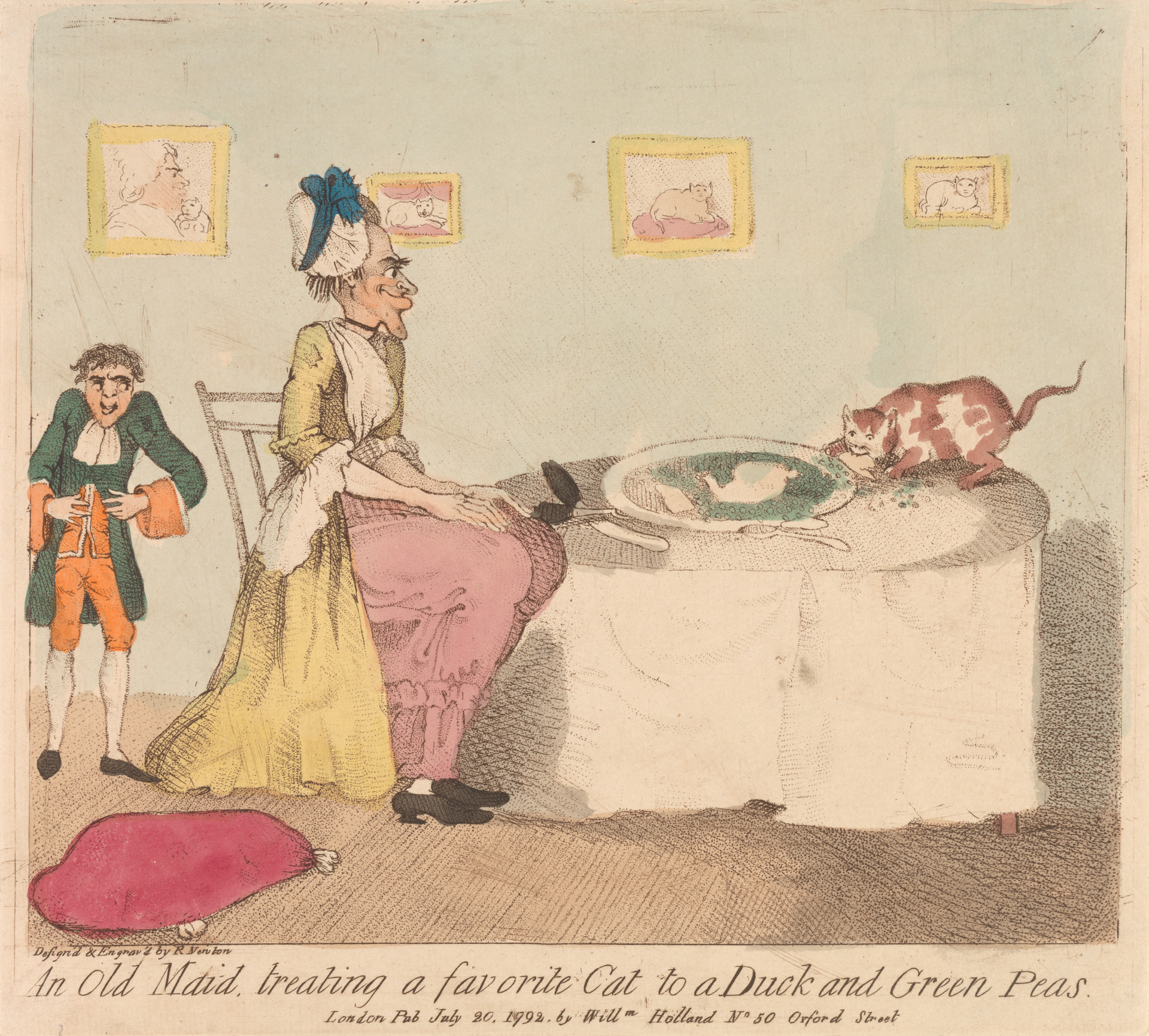
![Page [TP]](https://anthologyassetsdev.lib.virginia.edu/wollstonecraft-vindication-excerpted/pageImages/VIN-TP.jpg)
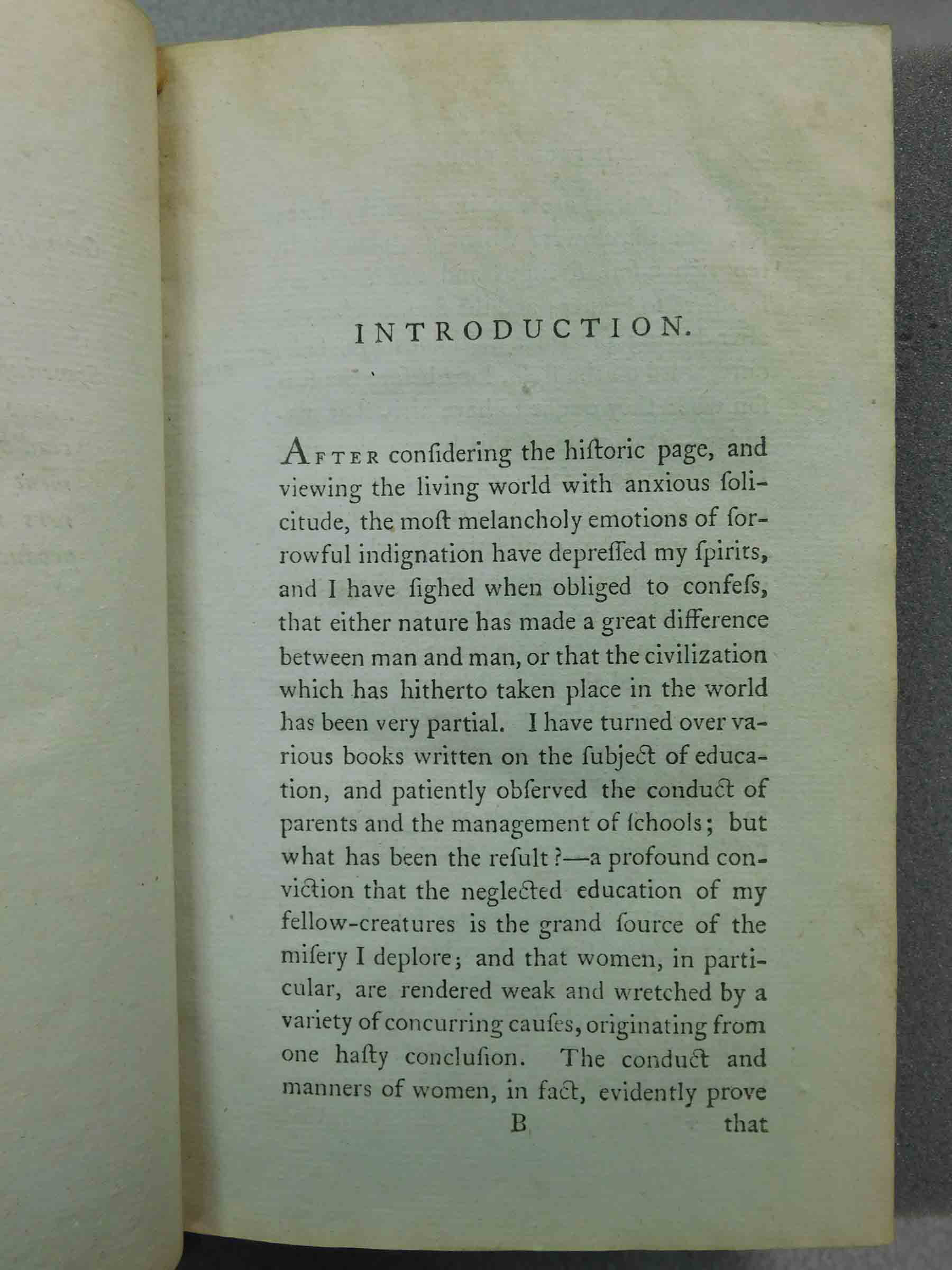
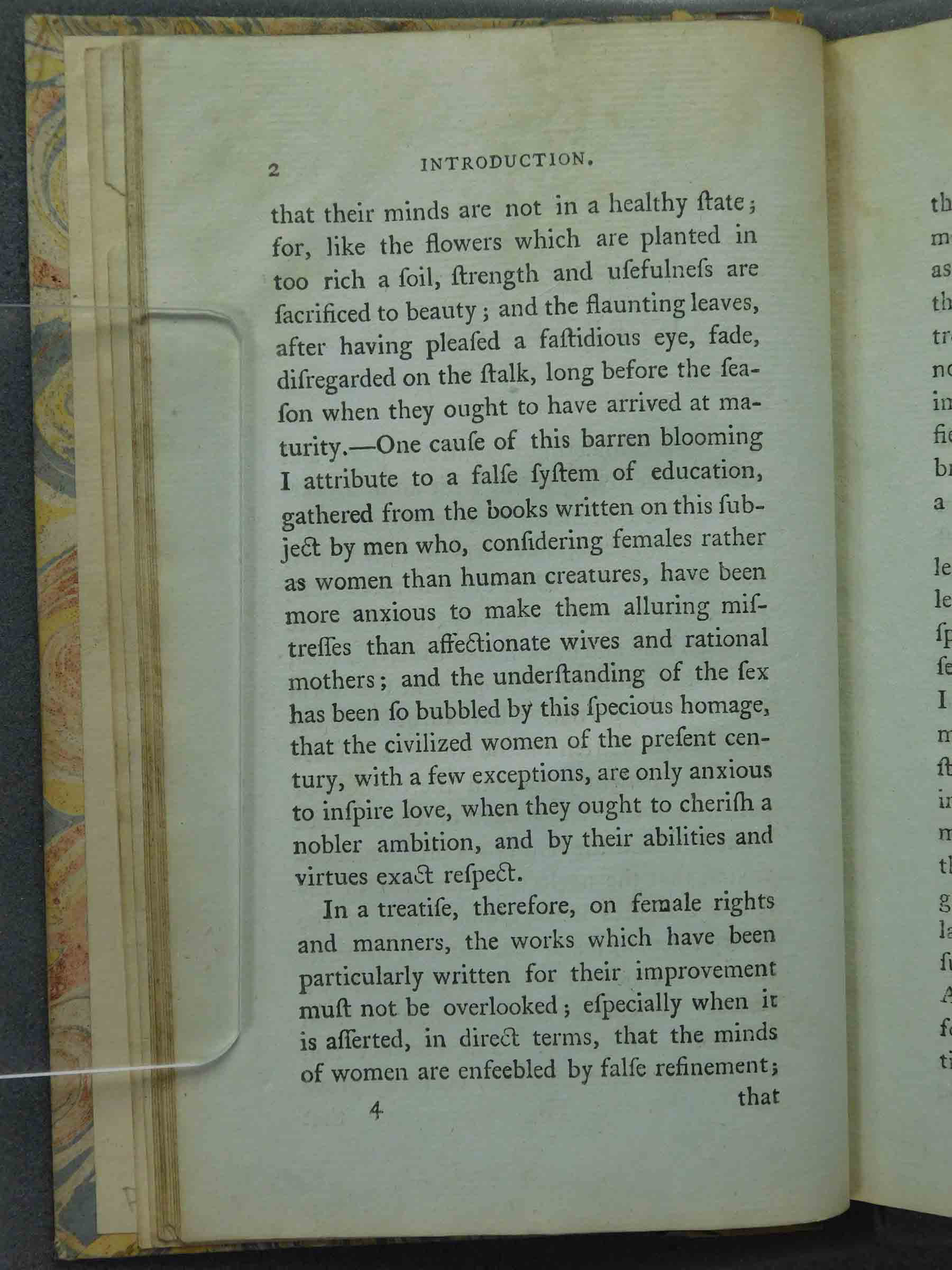

![Page 4 [break after pre-]](https://anthologyassetsdev.lib.virginia.edu/wollstonecraft-vindication-excerpted/pageImages/VIN-4.jpg)
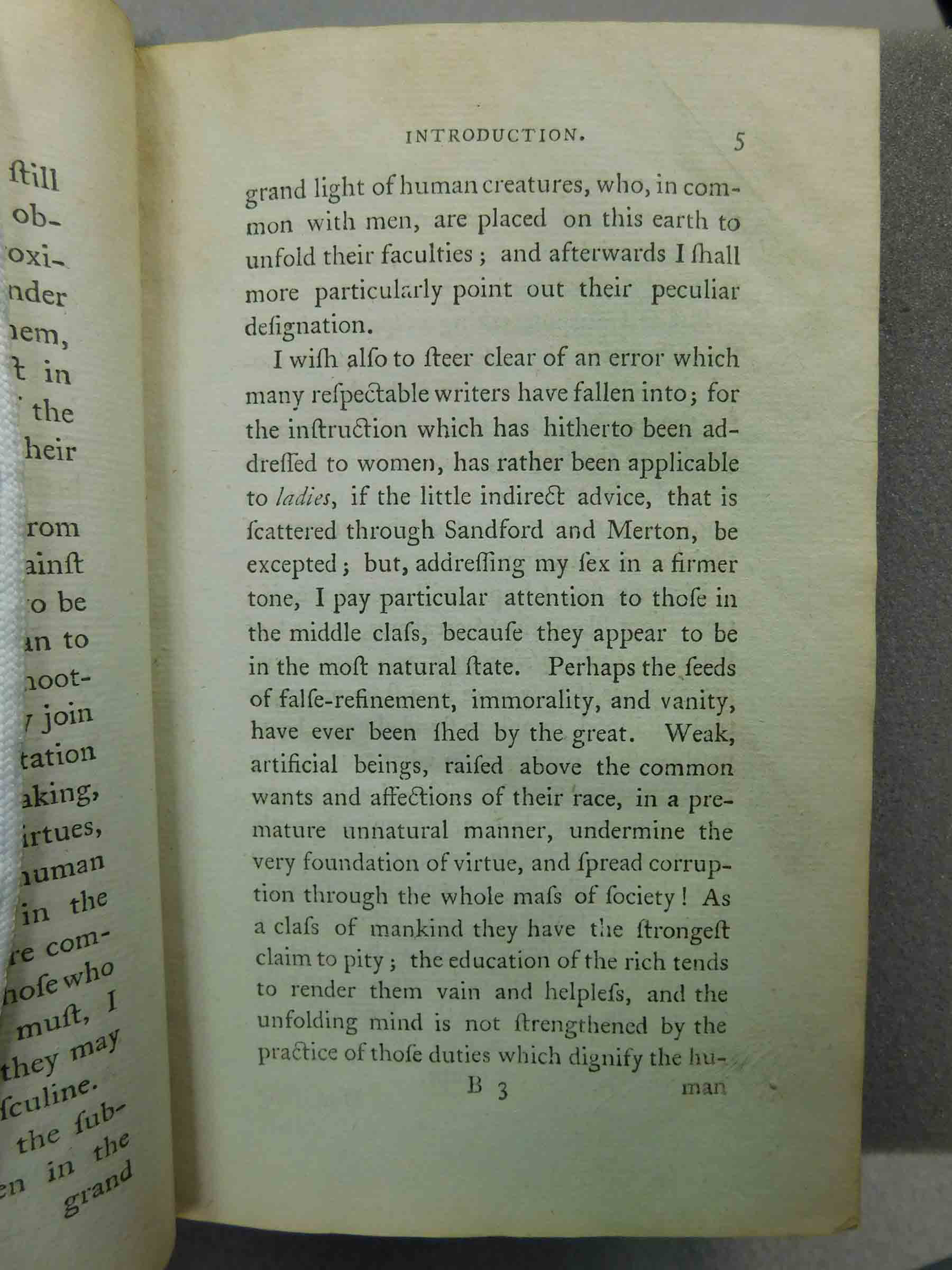
![Page 6 [break after 'hu-']](https://anthologyassetsdev.lib.virginia.edu/wollstonecraft-vindication-excerpted/pageImages/VIN-6.jpg)

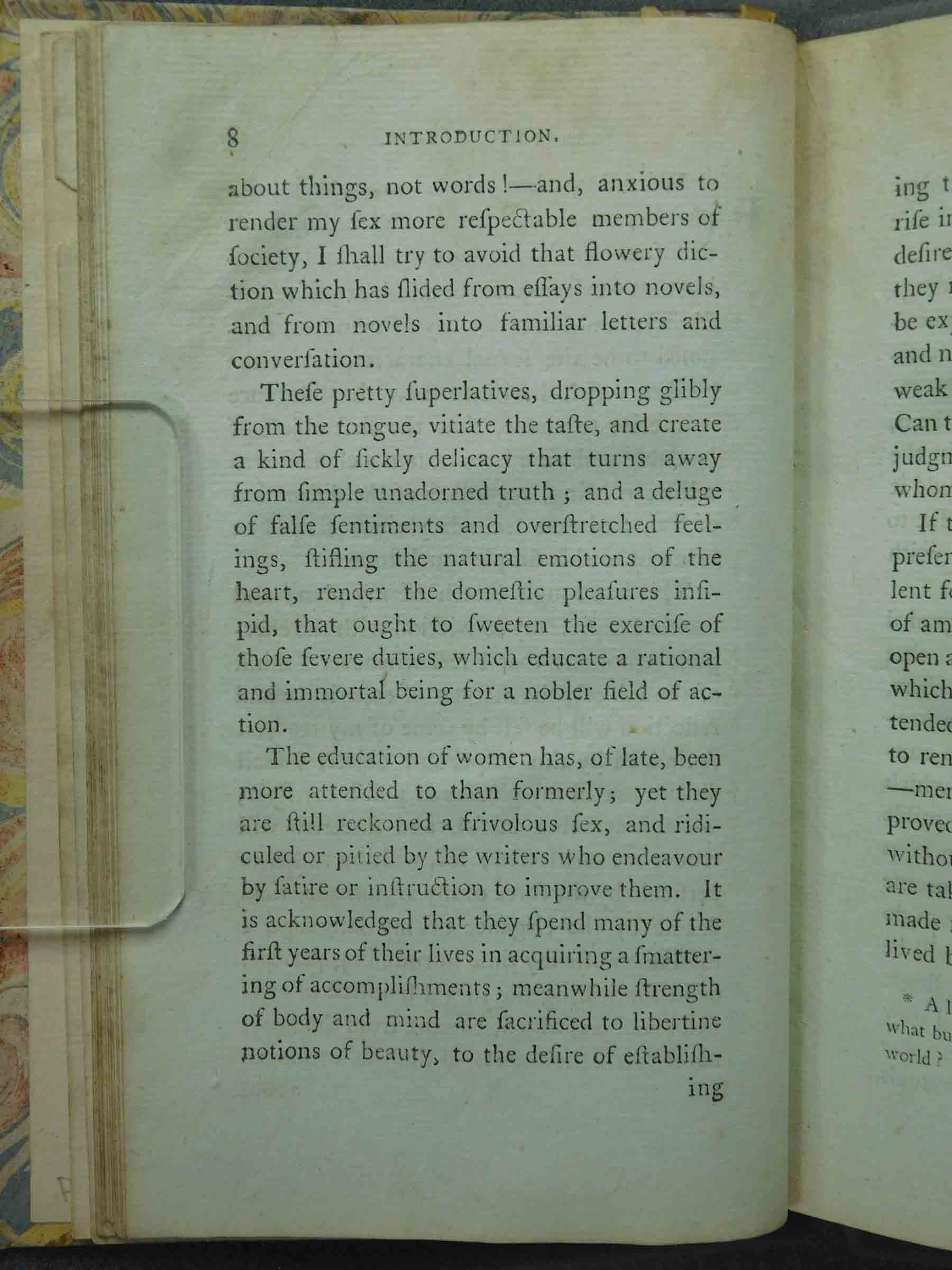
![Page 9 [break after 'establish-']](https://anthologyassetsdev.lib.virginia.edu/wollstonecraft-vindication-excerpted/pageImages/VIN-9.jpg)
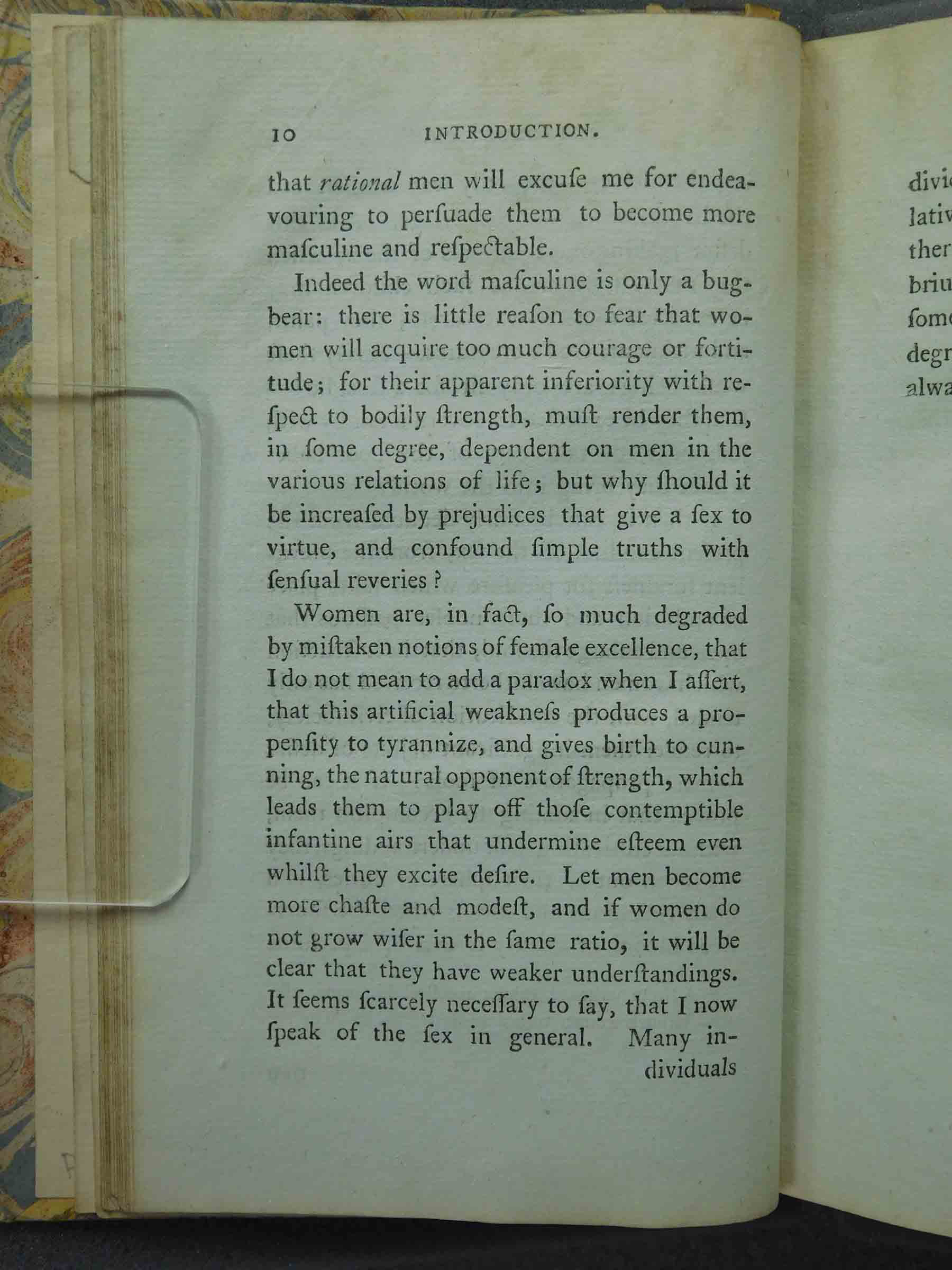
![Page 11 [break after 'in-']](https://anthologyassetsdev.lib.virginia.edu/wollstonecraft-vindication-excerpted/pageImages/VIN-11.jpg)
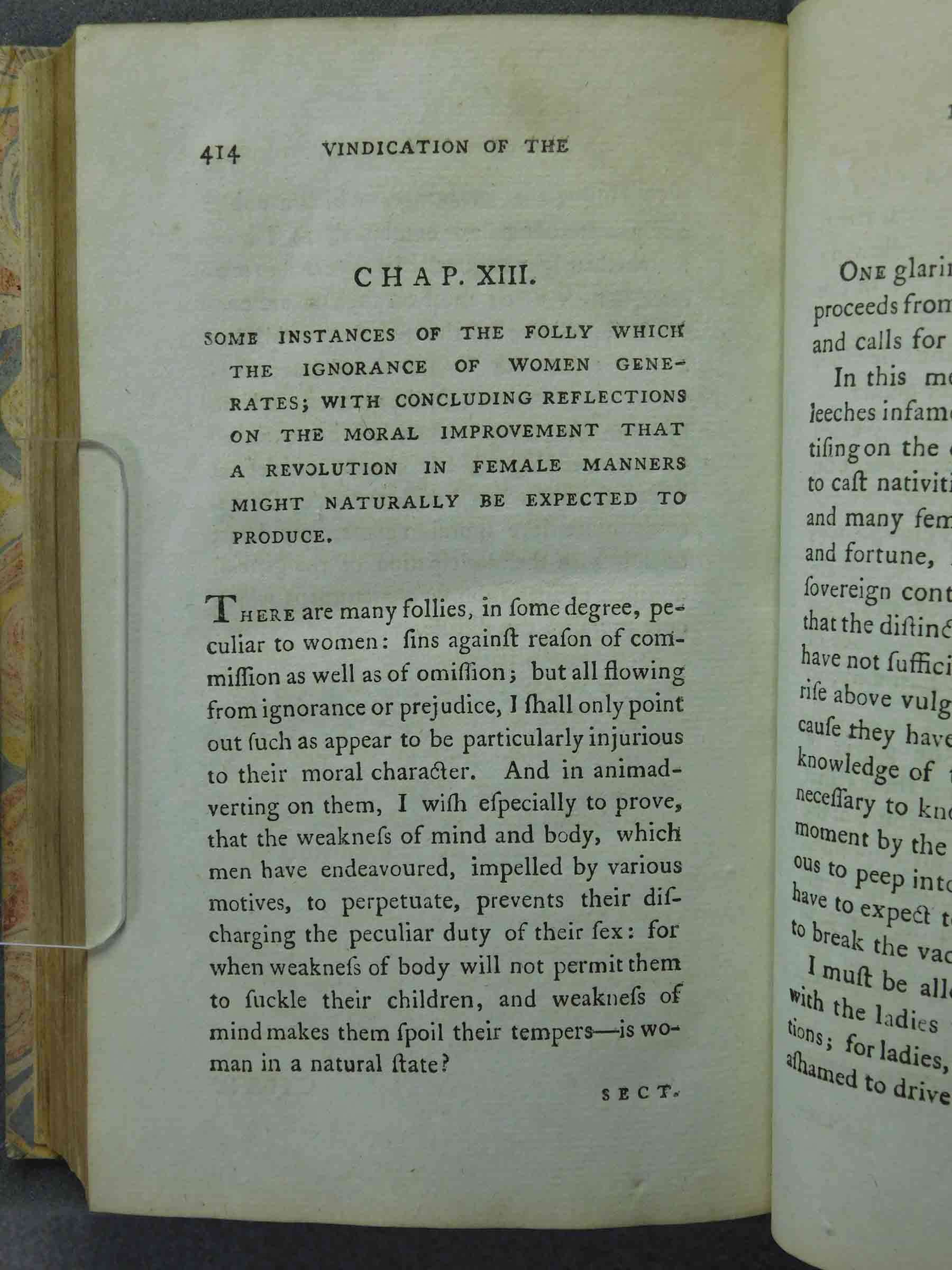
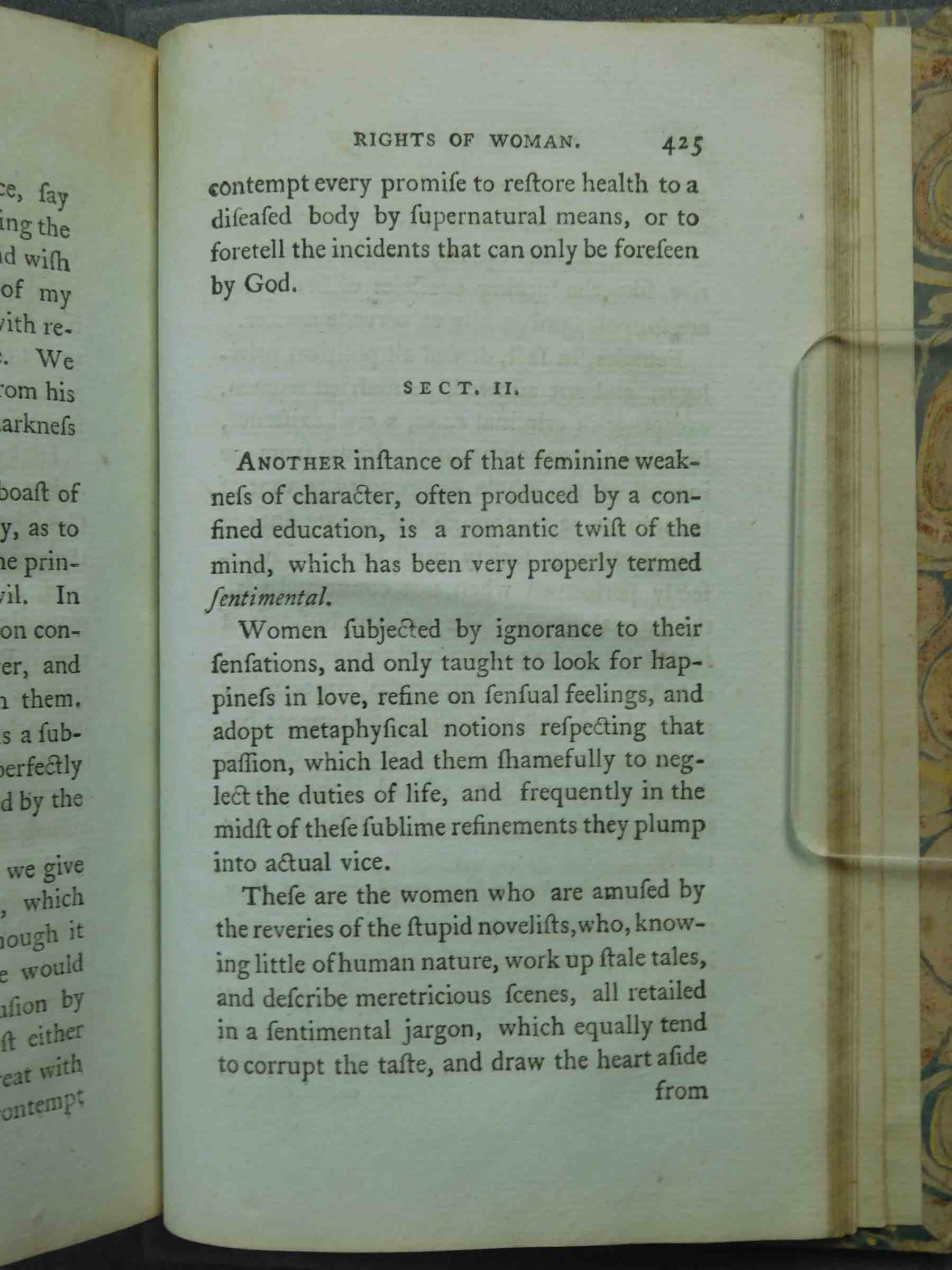
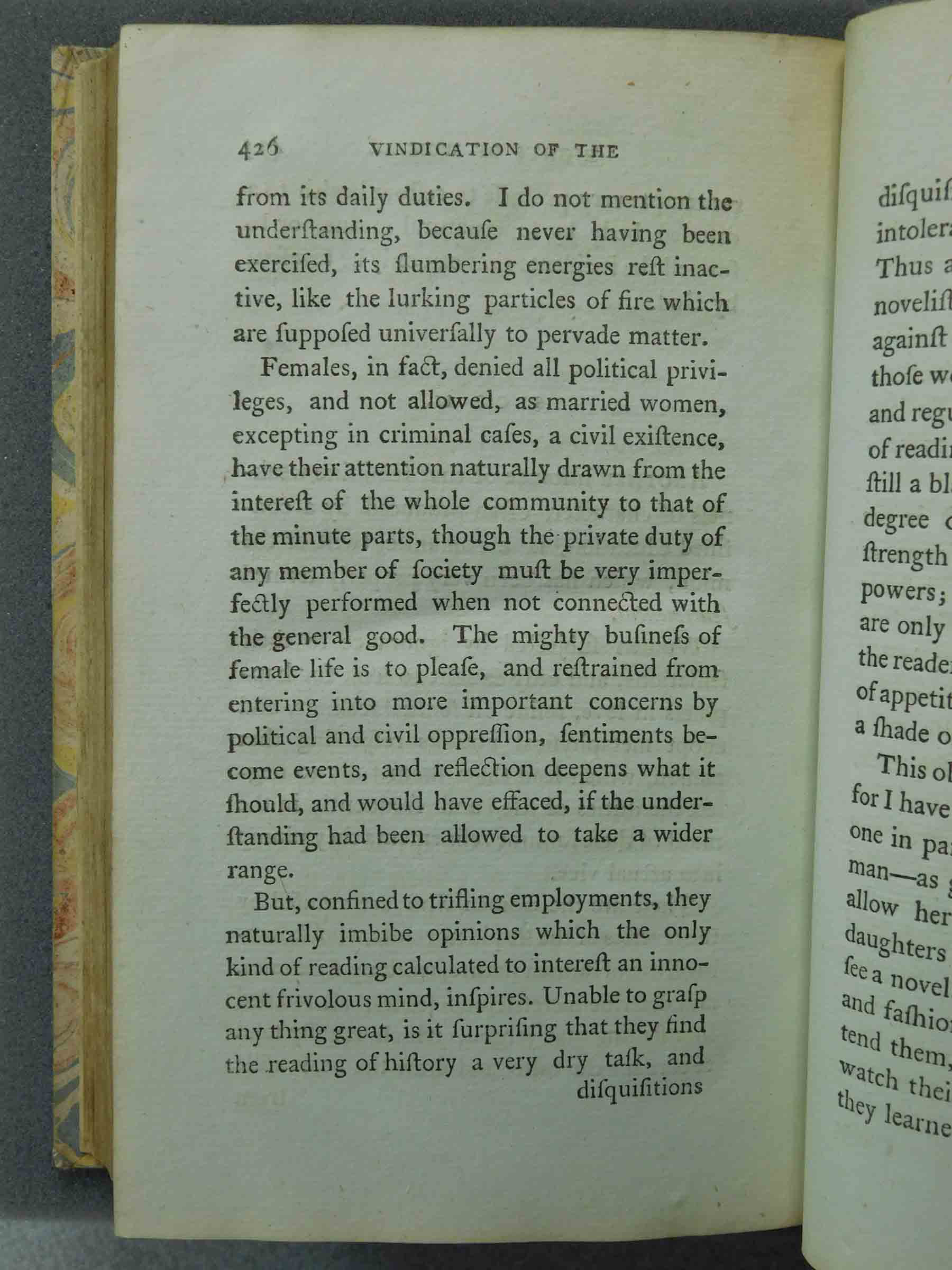
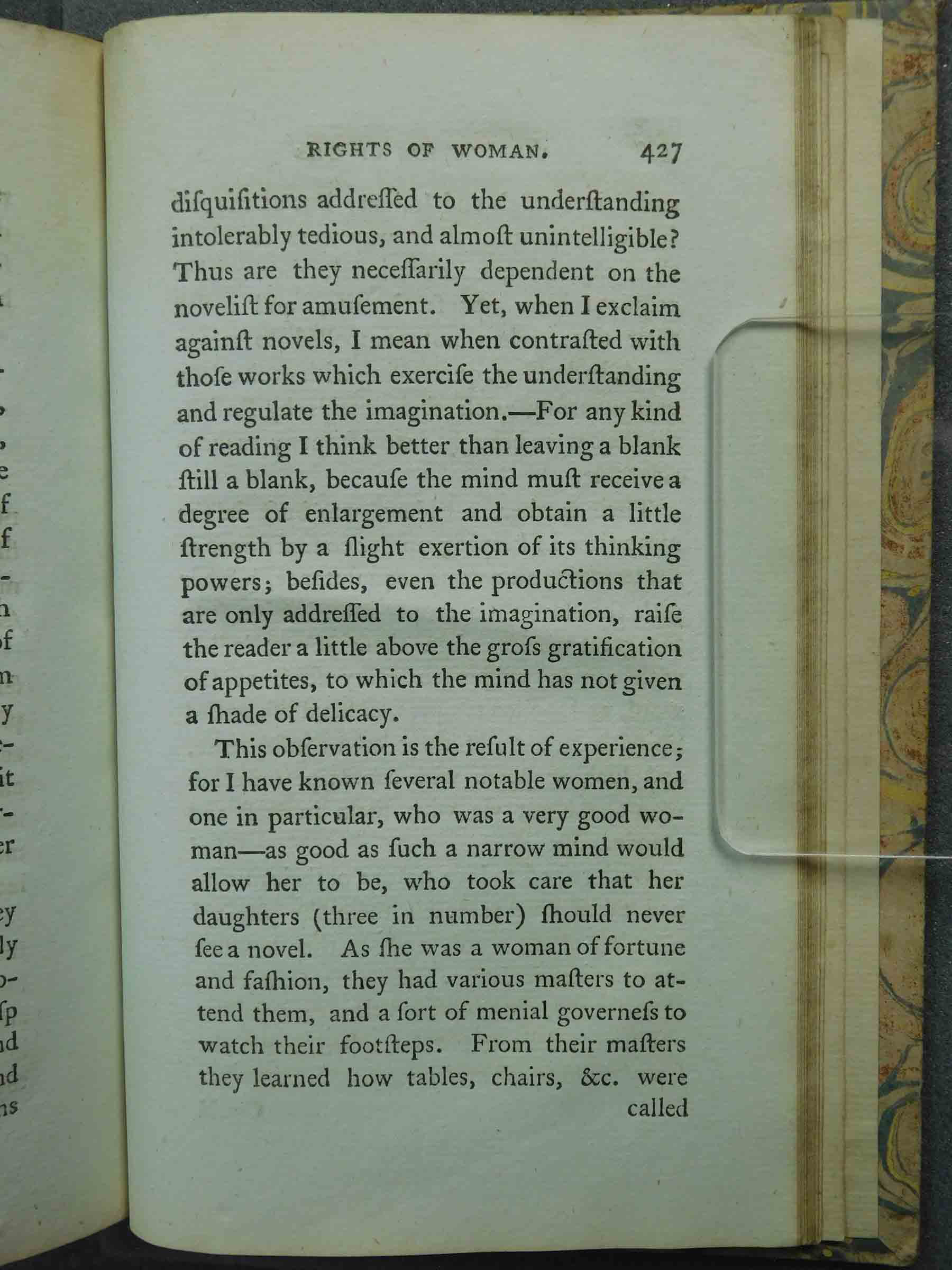


![Page 430 [break after 'ob-']](https://anthologyassetsdev.lib.virginia.edu/wollstonecraft-vindication-excerpted/pageImages/VIN-430.jpg)

